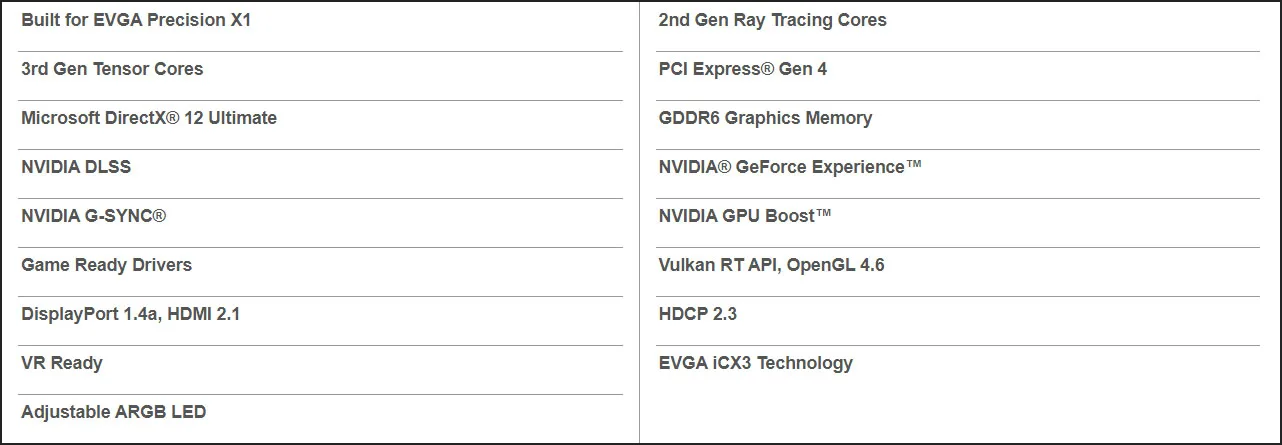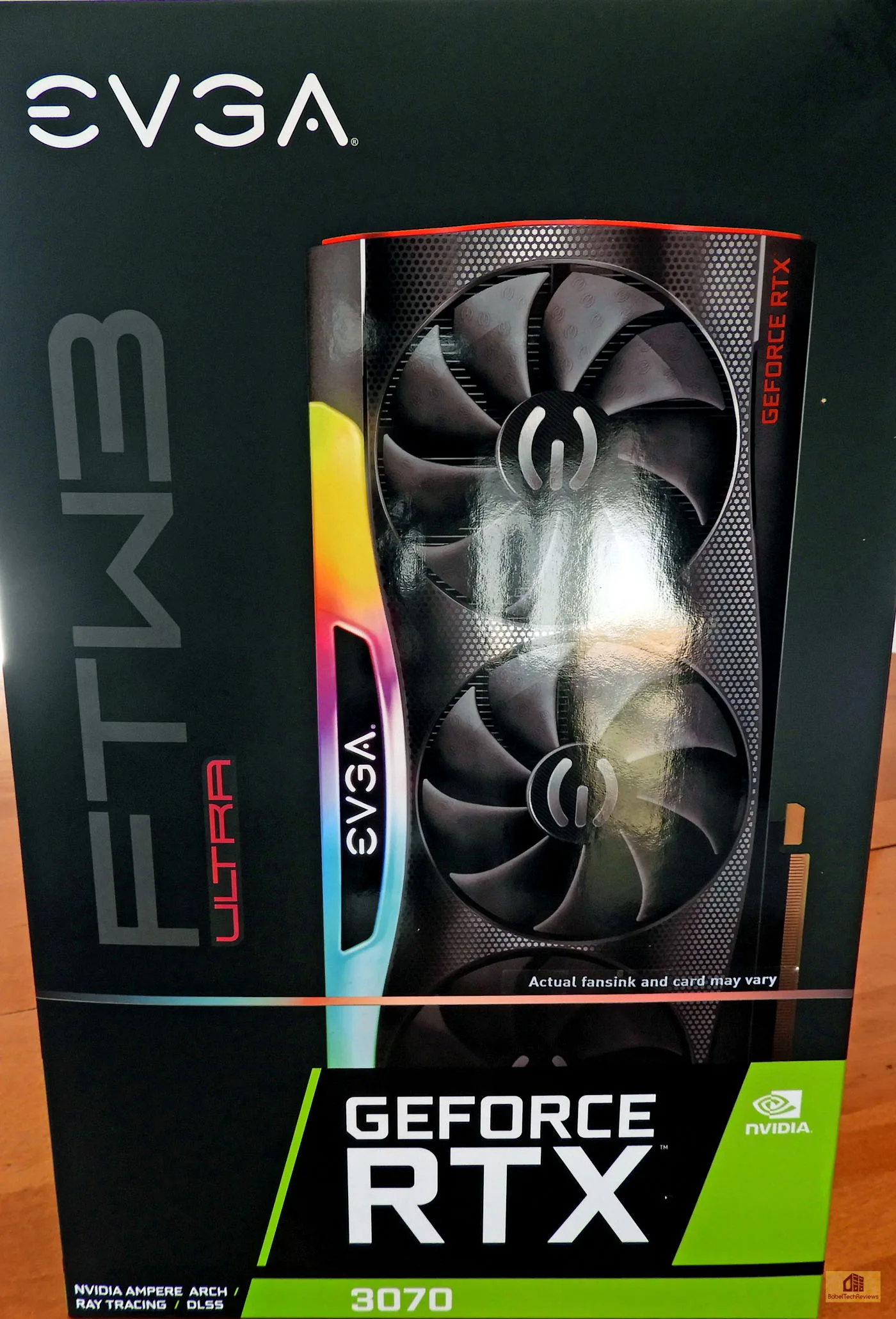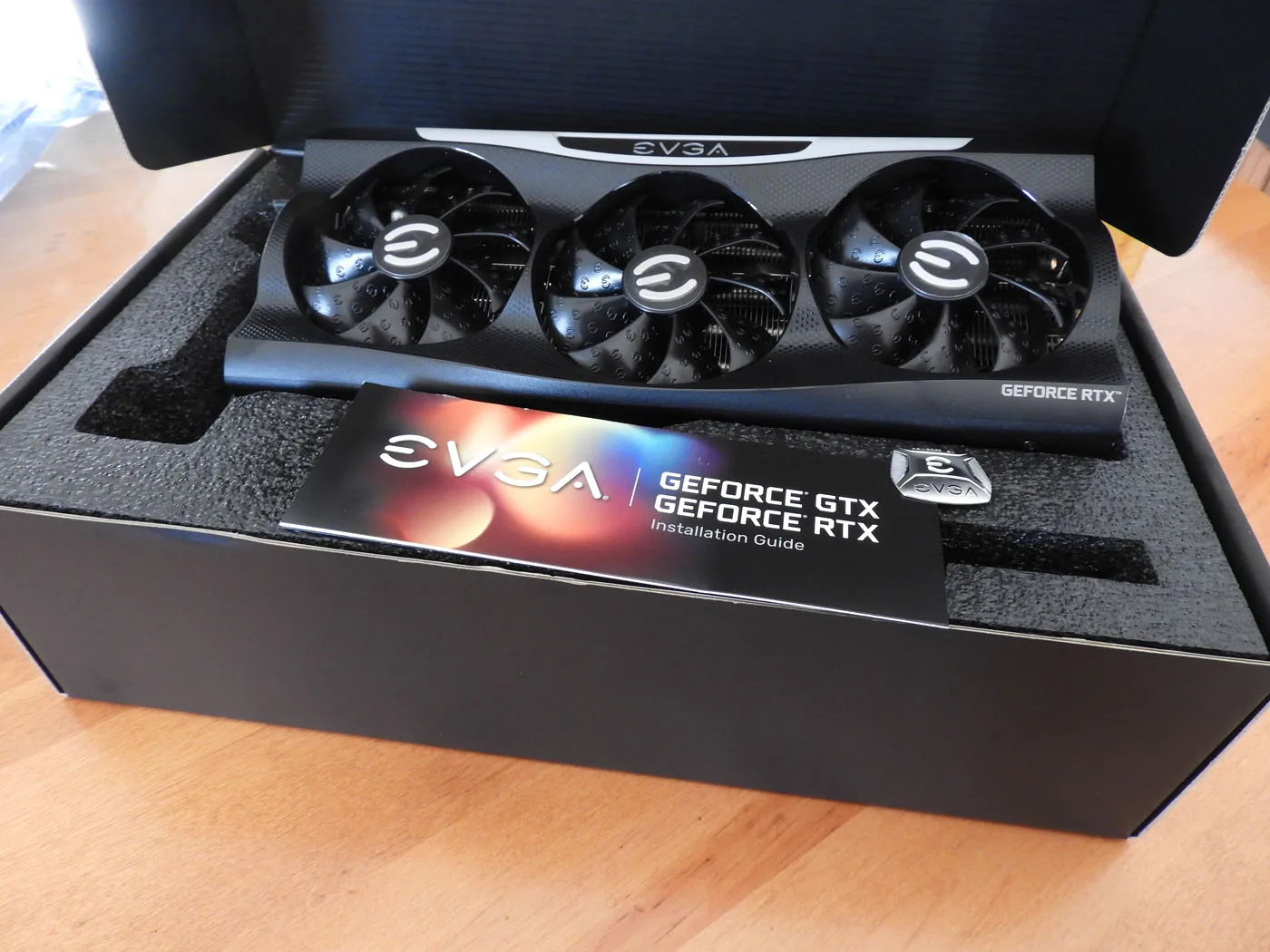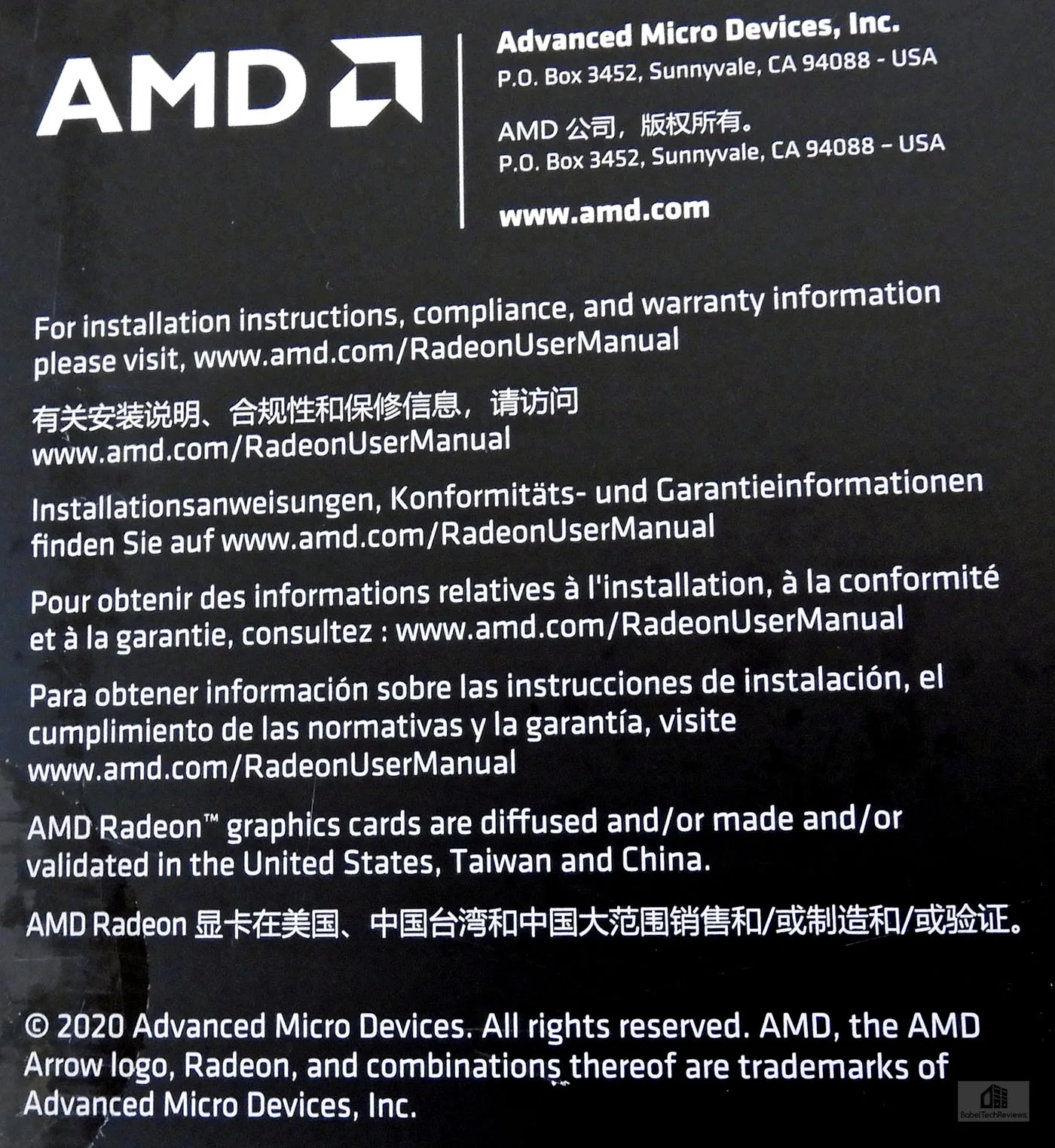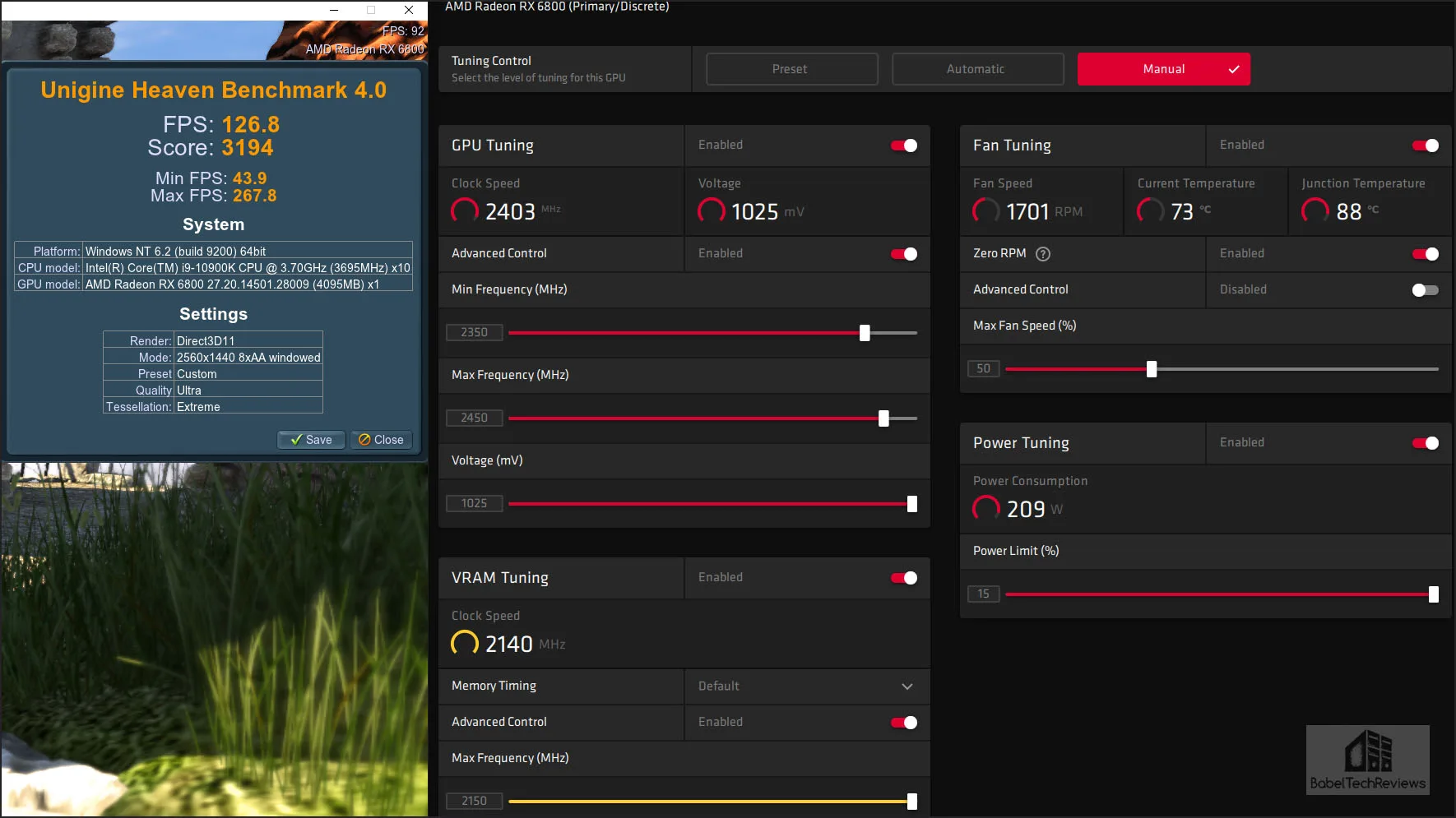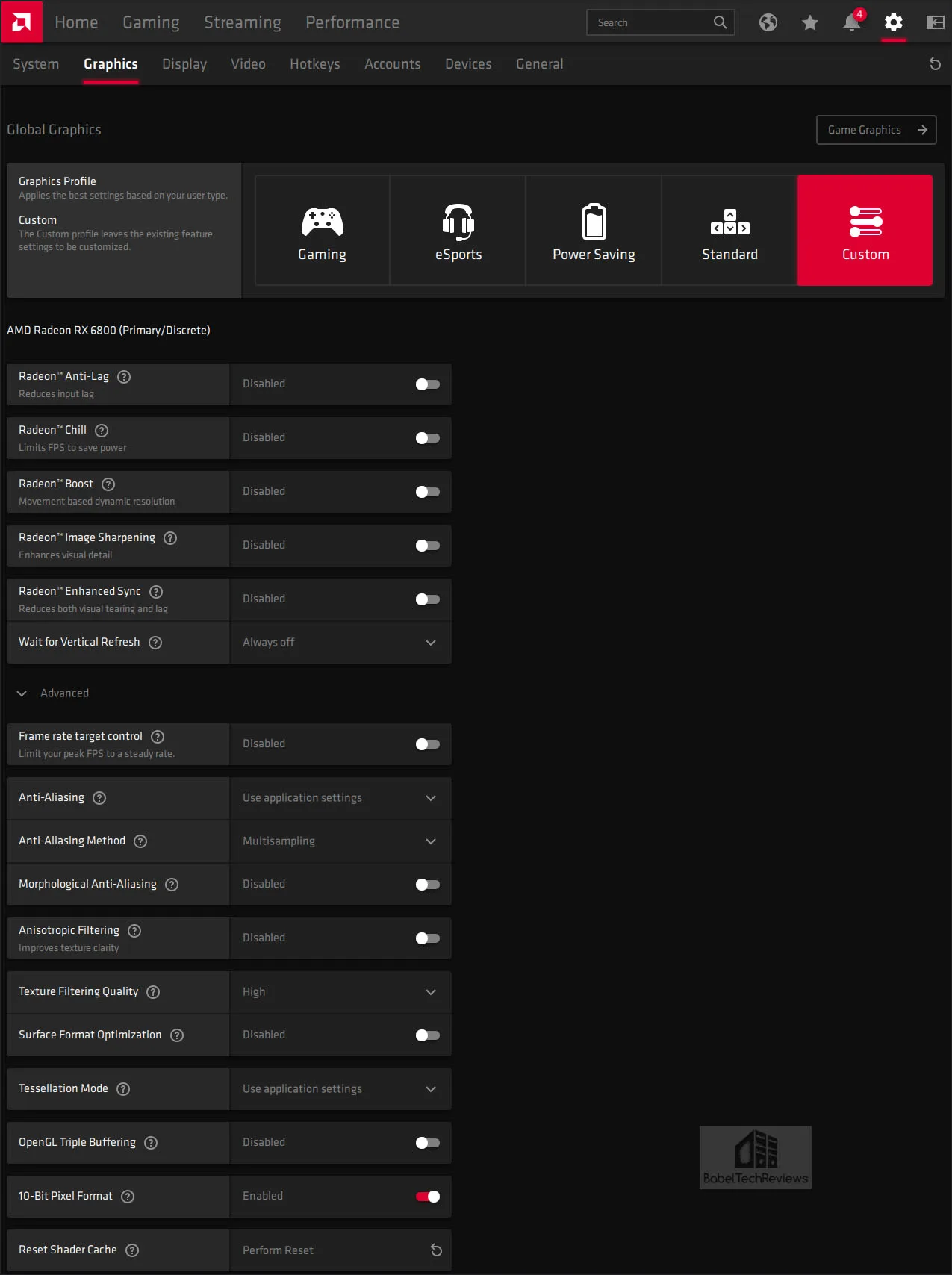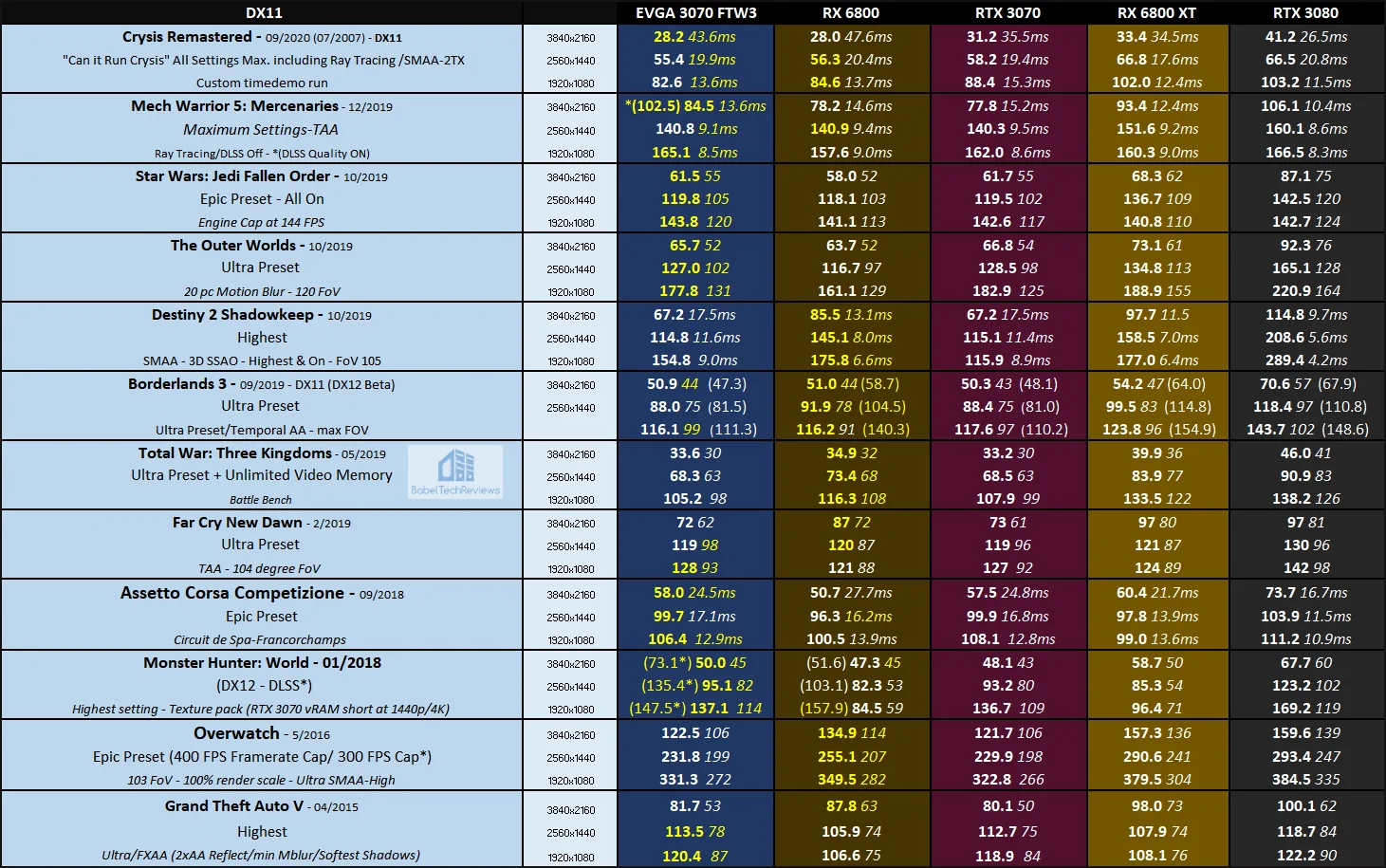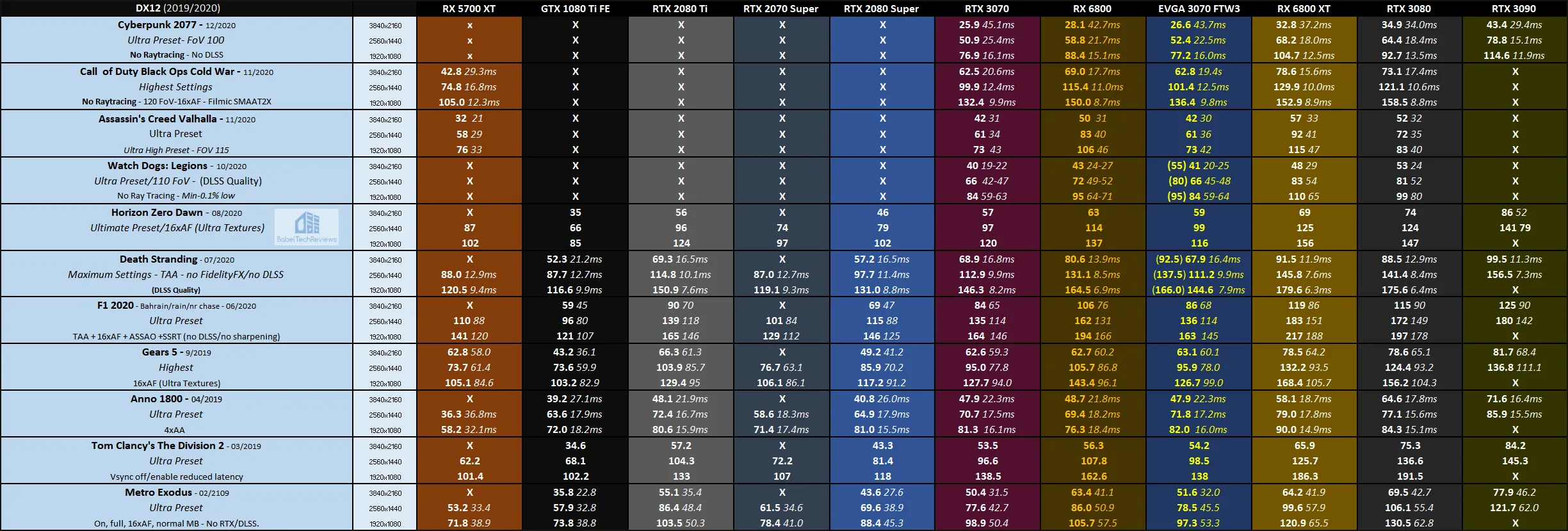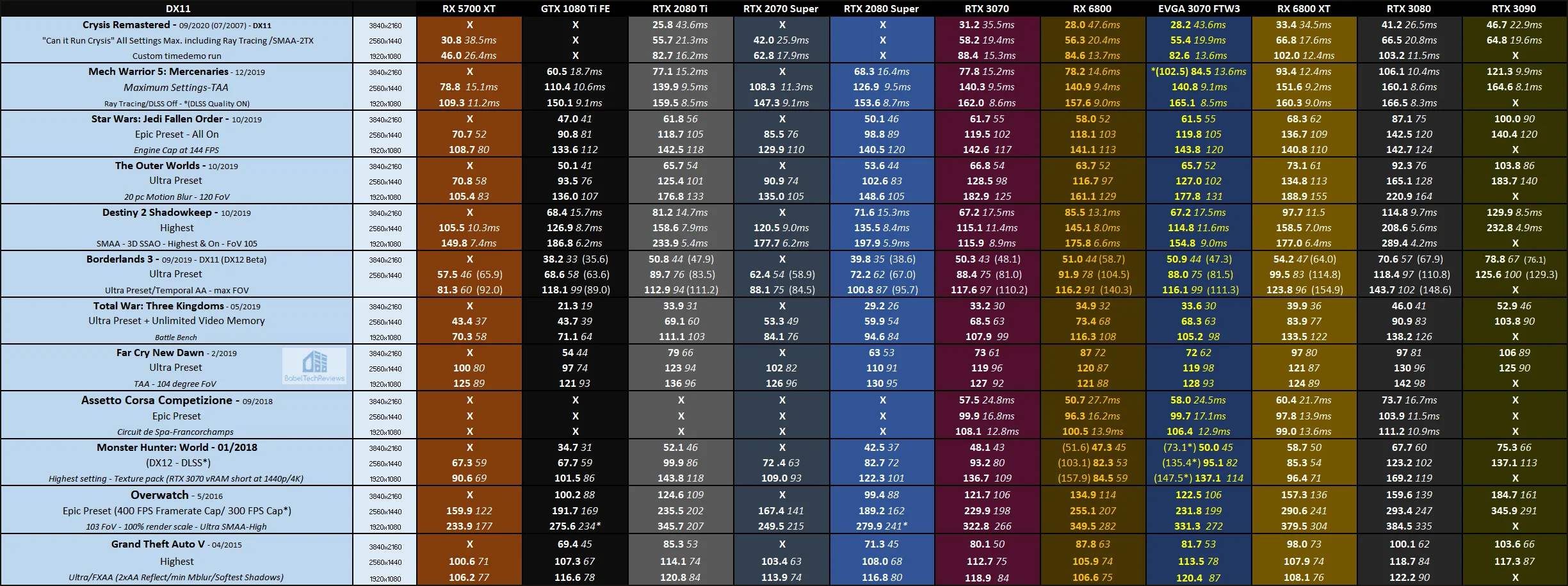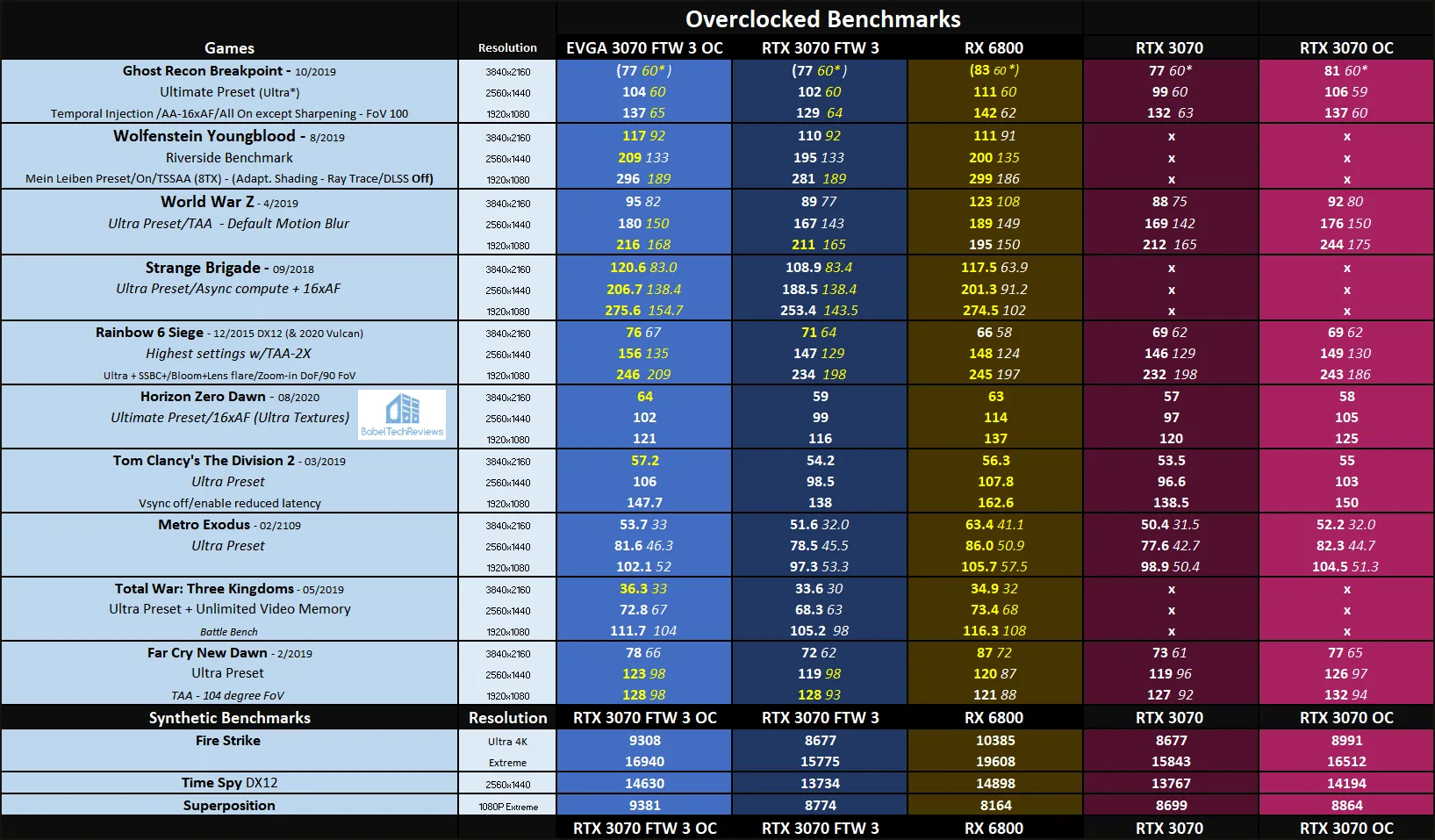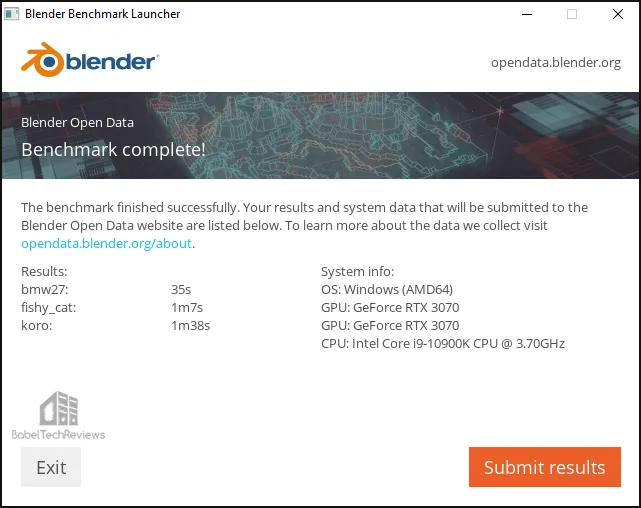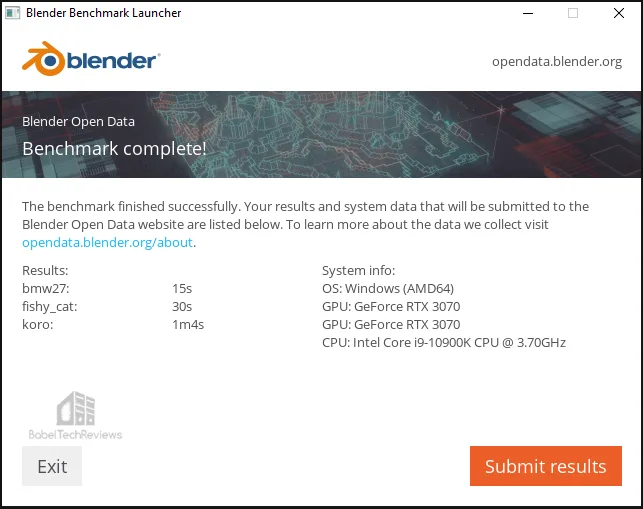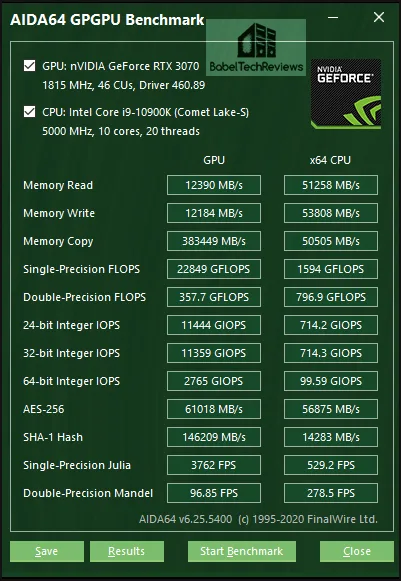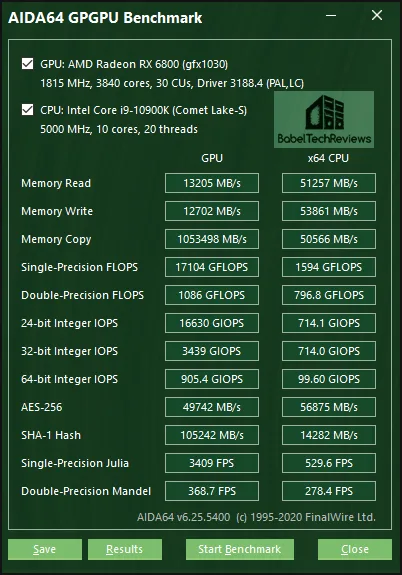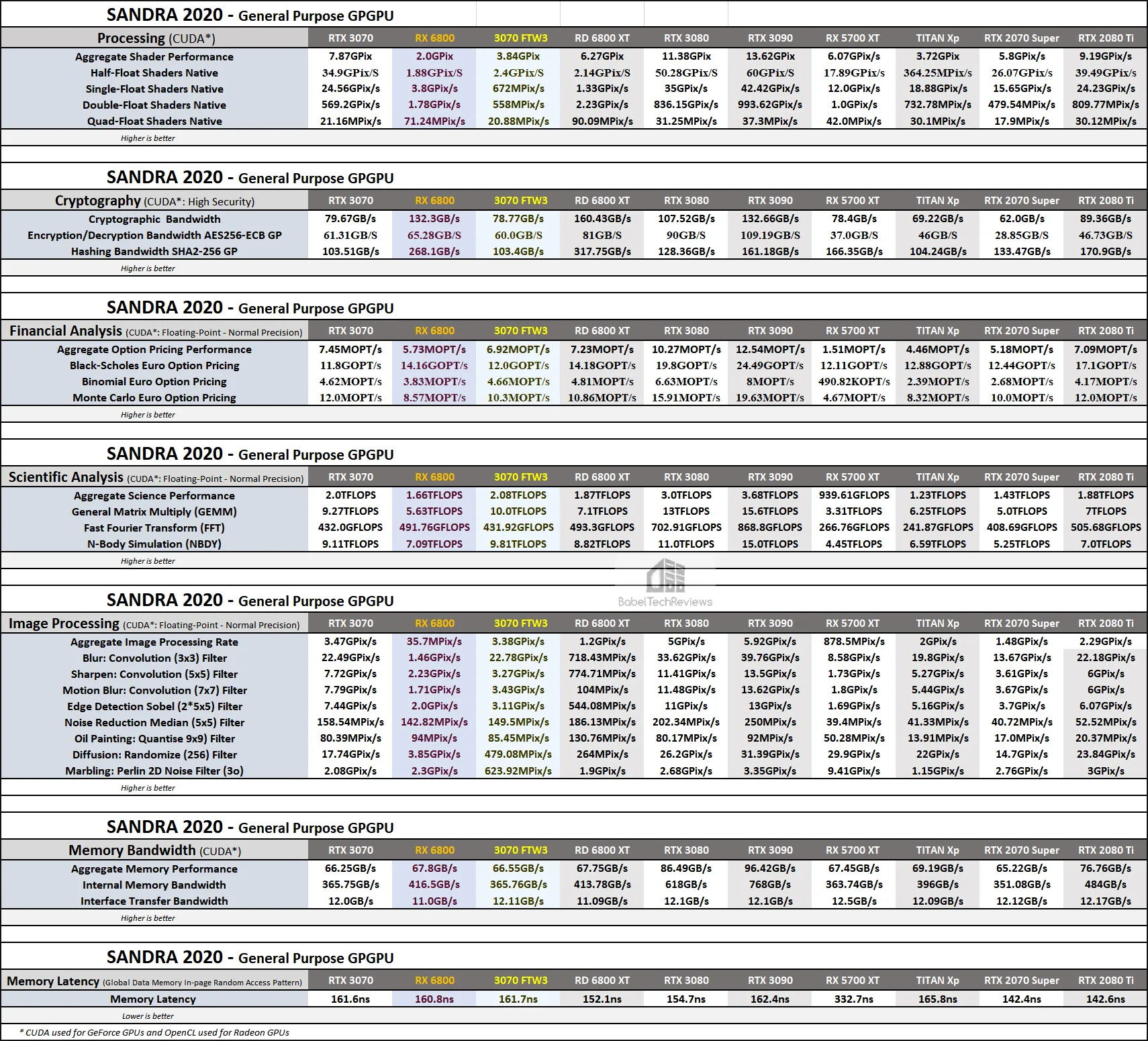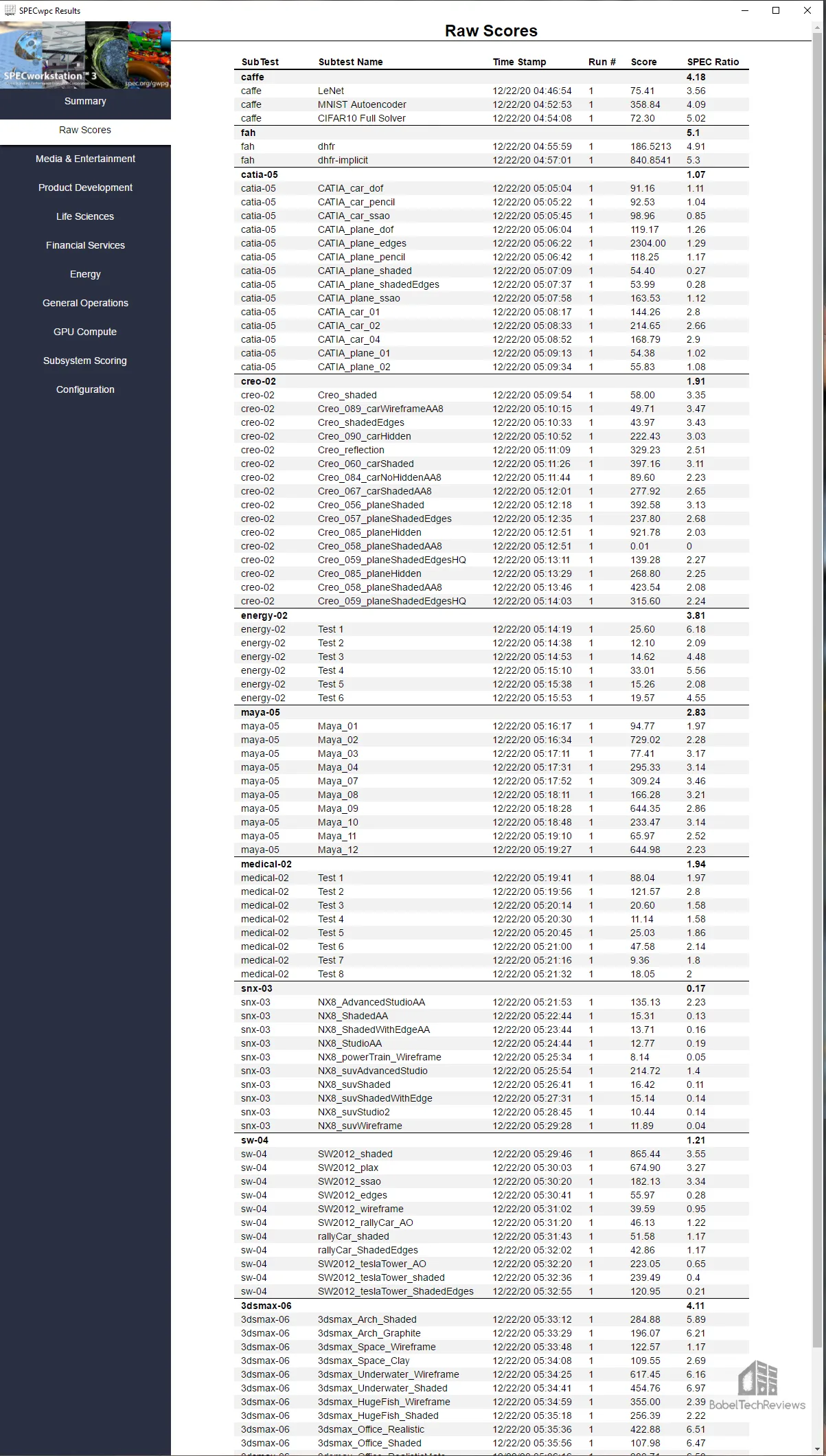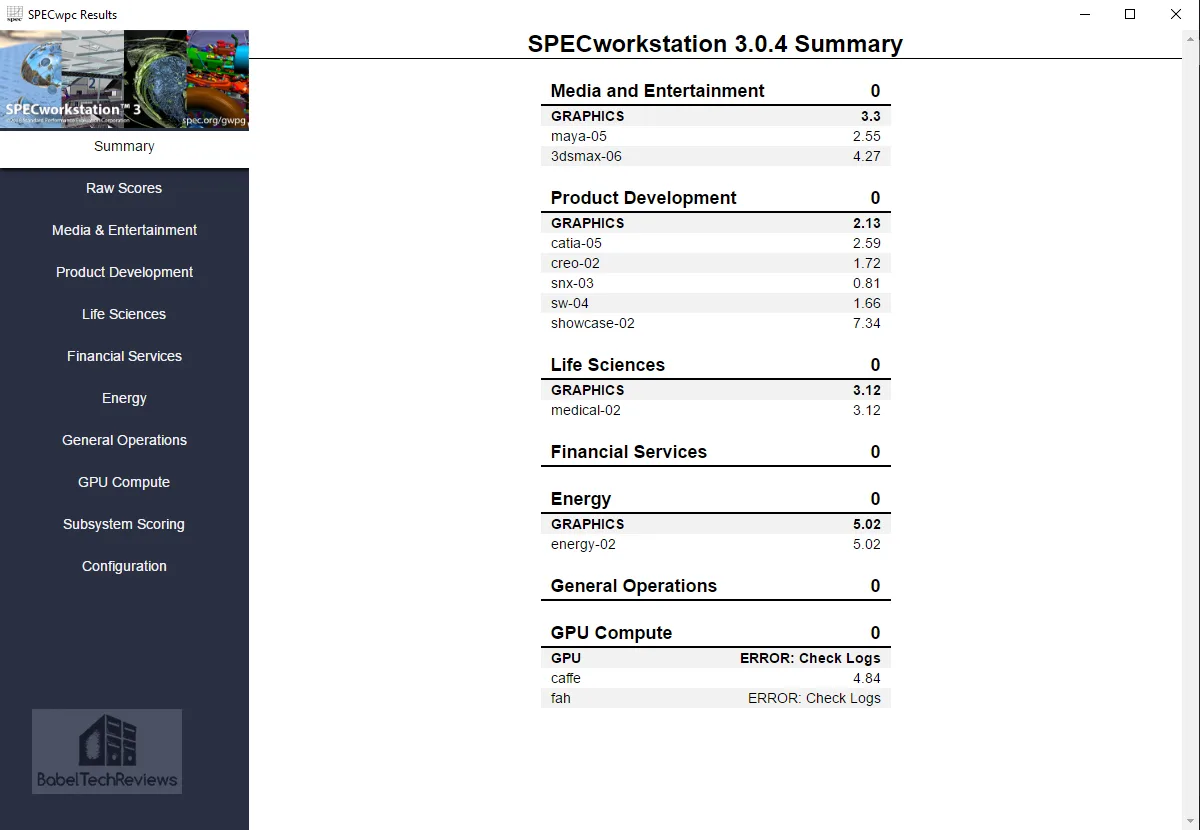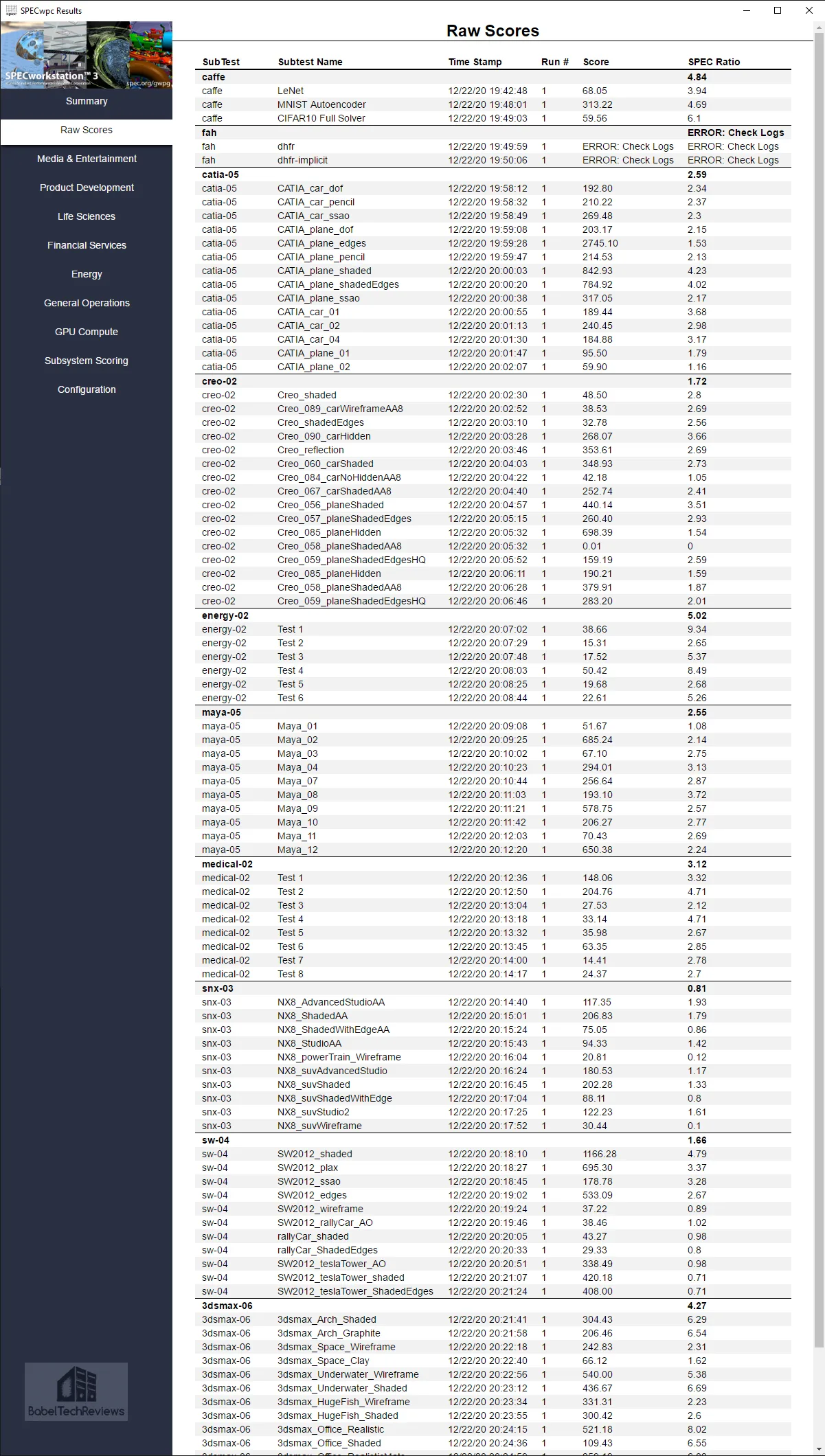The EVGA RTX 3070 FtW3 Ultra takes on the Reference RX 6800 in 35 Games, GPGPU & SPEC Workstation Benchmarks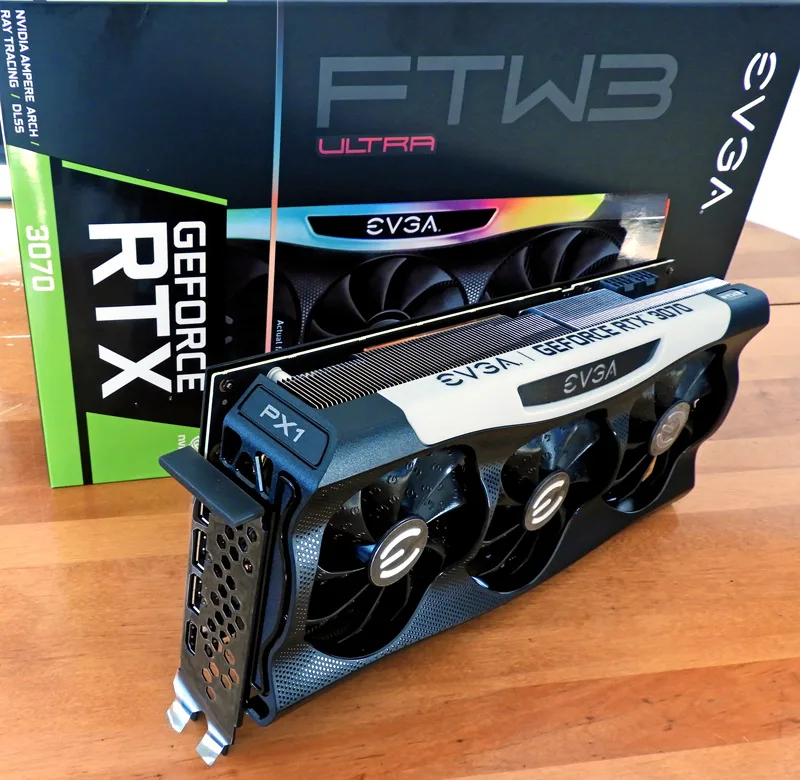
EVGA sent BTR a RTX 3070 FTW3 Ultra ($609) and we have been evaluating it for the past couple of weeks. We also received a reference RX 6800 ($569) from AMD within the same timeframe. Since these cards have become direct competitors because of being priced within 7%, they each deserve a full review. 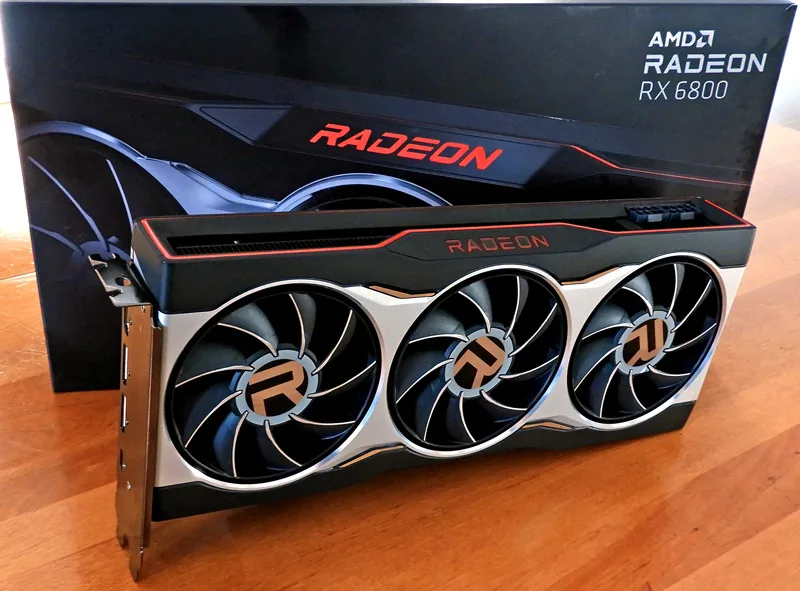
AMD sent us a reference RX 6800 the week after it launched. From our VR benchmarks, the RTX 3070 FE (Founders Edition $499) and the reference RX 6800 ($569) are in a similar class with the Radeon delivering higher unconstrained framerates which may support AMD’s justification for pricing it $70 higher than the FE. We use GPGPU, workstation, and SPEC benchmarks plus 35 games, directly comparing the reference RX 6800 with the $40 more expensive RTX 3070 FTW3 Ultra to see what the EVGA card at $609 brings over the RTX 3070 FE at $499.
BTR’s Test Bed
BTR’s test bed consists of 35 games and 3 synthetic game benchmarks at 1920×1080, 2560×1440, and at 3840×2160 as well as SPEC and GPGPU benchmarks. Our latest games include Cyberpunk 2077, Watch Dogs: Legions, Call of Duty Black Ops: Cold War, and Assassin’s Creed: Valhalla. We use a clean installation of Windows 10 64-bit Pro Edition, and our CPU is an i9-10900K which turbos all 10 cores to 5.1/5.0GHz, an EVGA Z490 FTW motherboard, and 32GB of T-FORCE Dark Z DDR4 3600MHz. The games, settings, and hardware are identical except for the cards being compared.
Let’s split this review into two parts – First, let’s take a closer look at the EVGA RTX 3070 FTW3 Ultra on the next page.
The EVGA RTX 3070 FTW3 Ultra – Specifications & Features, Unboxing, Overclocking & noise
Specifications & Features
The RTX 3070 is not based on the GA102 chip like the RTX 3080 and the RTX 3090, but rather it uses a separate smaller GA104 GPU chip. The RTX 3070 FE uses 64 SMs, 5888 CUDA cores, 184 3rd Generation Tensor and 46 RT cores, along with 184 Texture Units and 96 ROPs. The Boost Clock is 1730MHz, and 8192MB of GDDR6 at 7000MHz on a 256-bit memory bus provide 448GB/s bandwidth, all within a 220W total GPU power envelope.
EVGA’s site lists the RTX 3070 FTW3 Ultra specifications and features and they are very impressive as they build upon the reference version with a 1815MHz Boost Clock and the ability to overclock further manually than the RTX 3070 Founders Editions because of selected GPUs and higher user accessible voltage.

Surprisingly, there is no mention of a dual-BIOS which is a great feature for overclockers. Although the OC BIOS mainly sports a more aggressive fan profile without an idle fan stop, we used the OC BIOS for our benchmarking. In addition, multiple sensors across the board monitor VRM/memory temps in Precision X1.
Unboxing
Unlike with NVIDIA’s Founders Editions, the EVGA RTX 3070 FTW3 Ultra comes in a traditional style box that advertises Ampere architecture, DLSS, and ray tracing.
The back of the box lists the key features in English, French, and Russian putting special emphasis on the Ampere architecture being second generation ray tracing cores and third generation tensor cores. 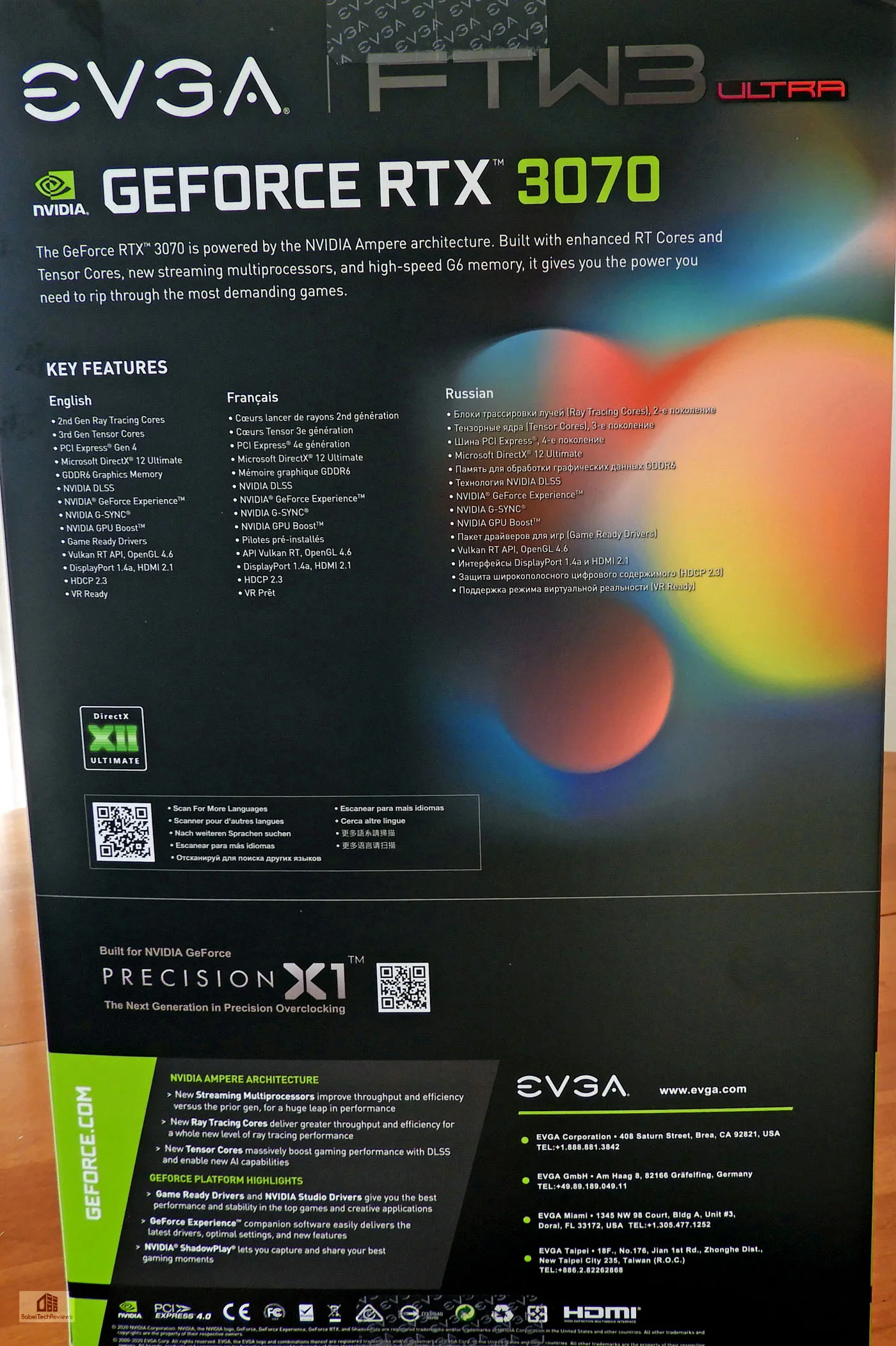
The box also states it is “VR Ready” but we did not see specifications, PSU requirements, nor information as to what is inside the box.
Inside the box and beneath the card are an installation guide and warranty information, plus a metal EVGA badge.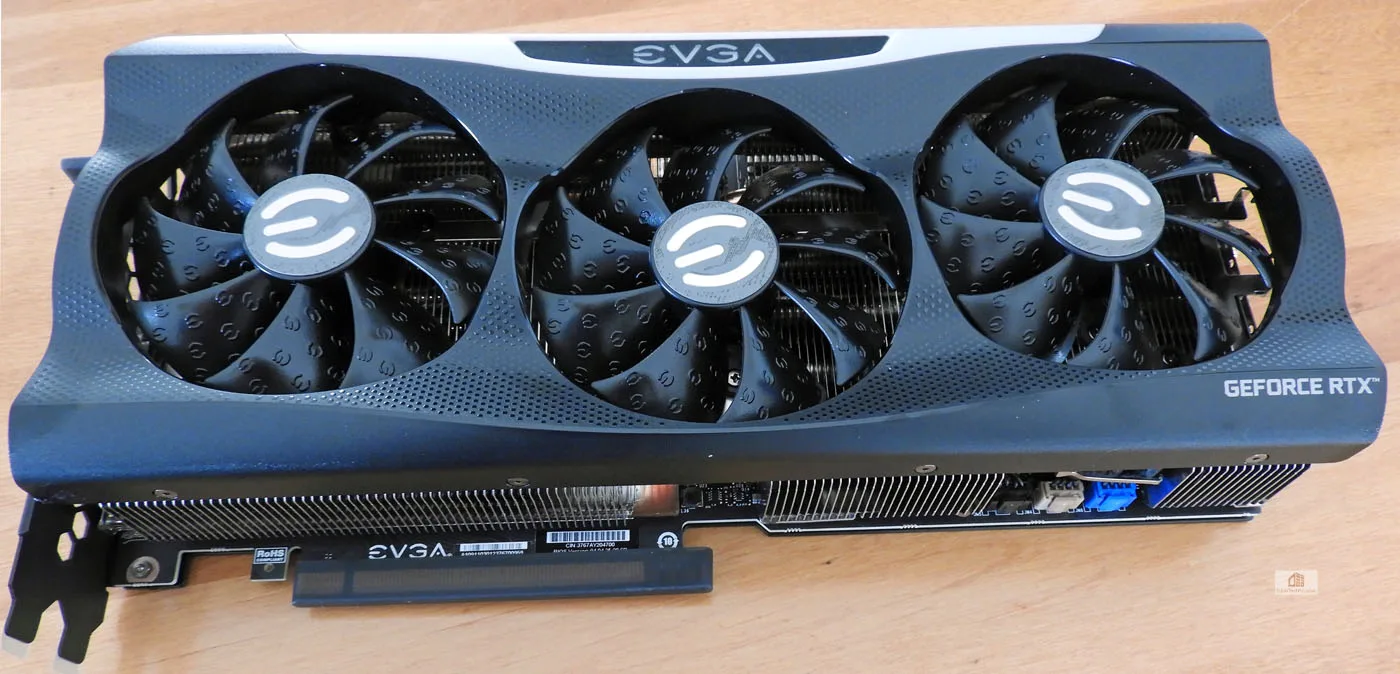
A completely redesigned shroud creates a very cool industrial look for the EVGA RTX 3070 FTW3 Ultra to provides a premium and solid heavy feel to it. It is a moderately heavy 2.75-slot card with three cooling fans. According to EVGA, triple HDB fans iCX3 technology offer higher performance cooling resulting in less acoustic noise. These iCX3 fans feature a second generation HDB active motor for silent 0dB mode, asyncronous fan mode, and a special upraised “E” pattern on the blades with the goal of a very quiet card.
It’s height is 5.38 in (136.75mm) and length is 11.81 in (300mm). 
Turning the card over, we see a similar unique design with small hexagonal cutouts in the backplate. Some may not like the red line on the backplate as white, gray, or black may have been a more neutral choice fitting in with the overall design better. This card is designed to keep the GPU cool including by using a short PCB, and inside the card from its edges we see mostly all heatsink fins.
The plastic panel has RGB lighting with 60 LEDs that may be customized extensively using EVGA’s Precision X1 software. Two 8-pin PCIe connectors are required to supply external power to the card since most FTW cards are good overclockers. The FTW3 is rated to draw 220W at stock but may pull 50W or more when overclocked, and EVGA recommends a decent 650W PSU to power it.
There is very large surface area for cooling so the heat is readily transferred to the fin stack and the triple fans exhaust some heat out of the back and through the backplate cutouts, but especially from the top of the card into the case’s airflow.
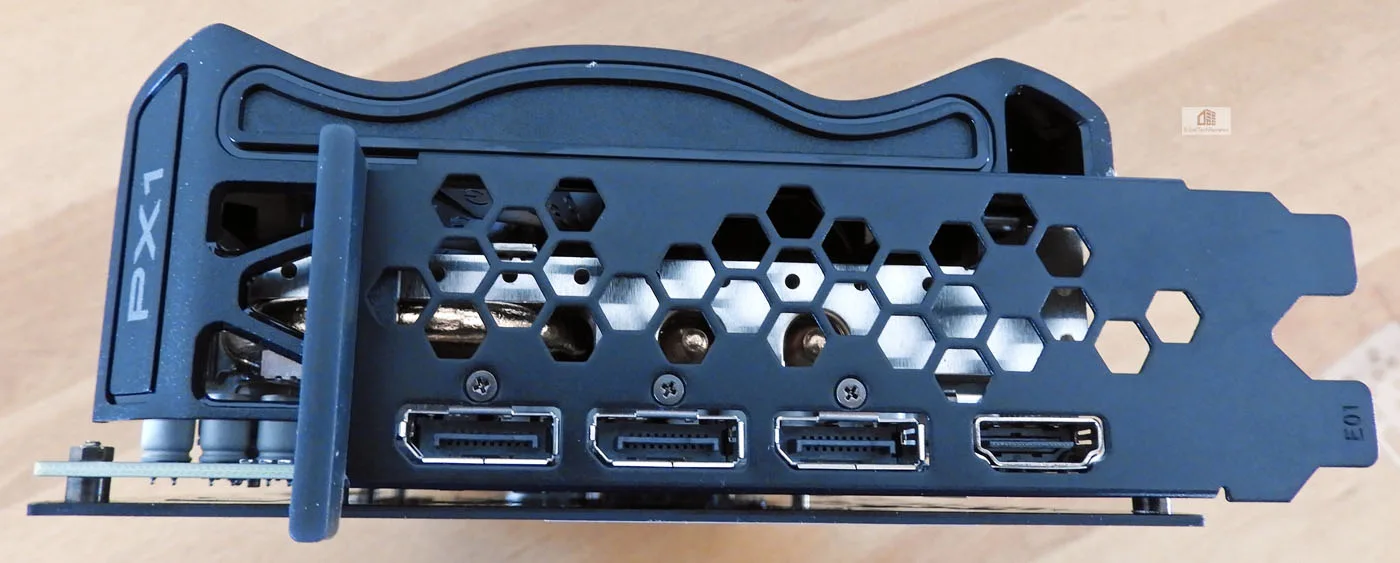 The IO panel has a large air vent and four connectors. The connectors are similar to the Founders Edition of the RTX 3070. Three DisplayPort 1.4 connectors are included, and the HDMI port has been upgraded from 2.0 to 2.1 allowing for 4K/120Hz over a single HDMI cable.
The IO panel has a large air vent and four connectors. The connectors are similar to the Founders Edition of the RTX 3070. Three DisplayPort 1.4 connectors are included, and the HDMI port has been upgraded from 2.0 to 2.1 allowing for 4K/120Hz over a single HDMI cable.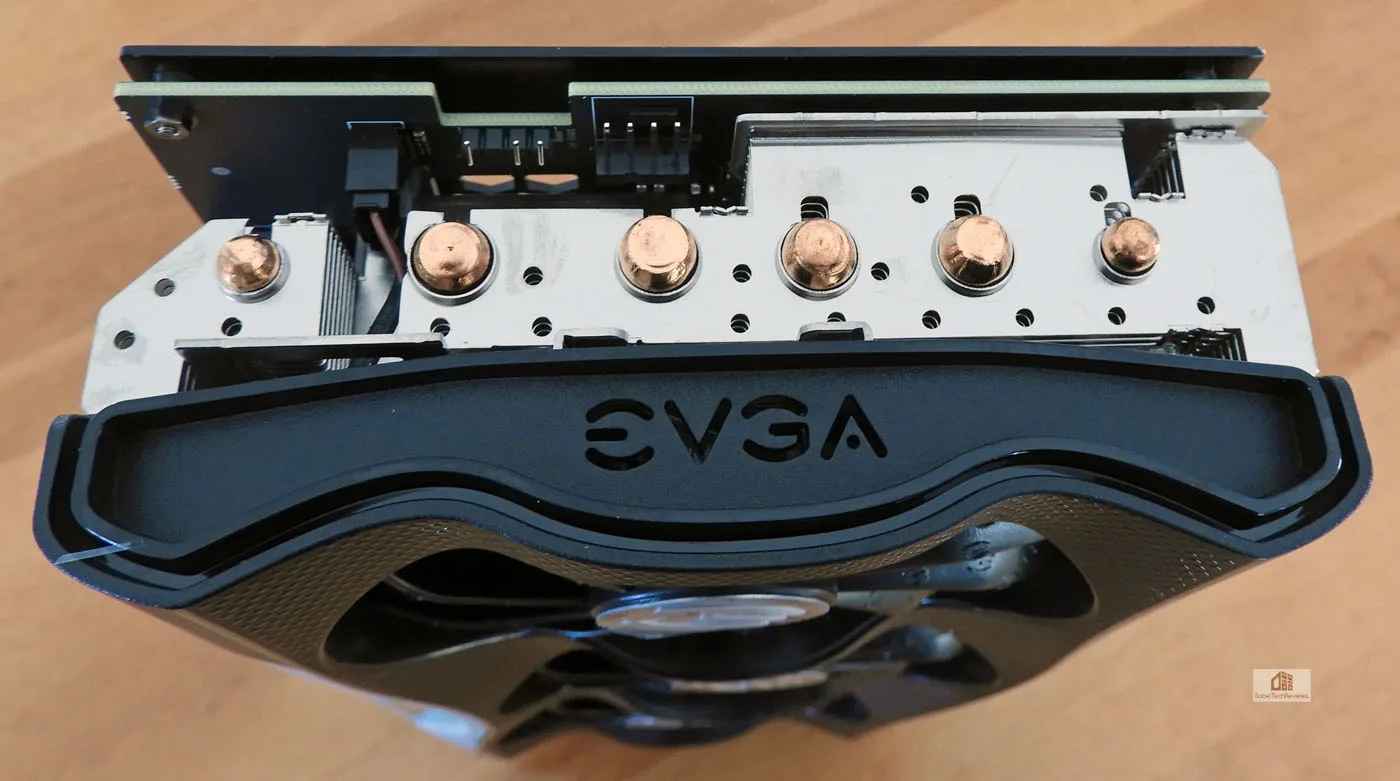
In our opinion, the EVGA RTX 3070 FTW3 Ultra is a good-looking card with a unique industrial style and it looks good in any case. The FTW3 sports a Dual BIOS which is always a solid advantage for overclockers looking to push the card’s limits. And multiple sensors across the board for monitoring VRM/memory temps in Precision X1 giving enthusiasts more fine tuning controls.
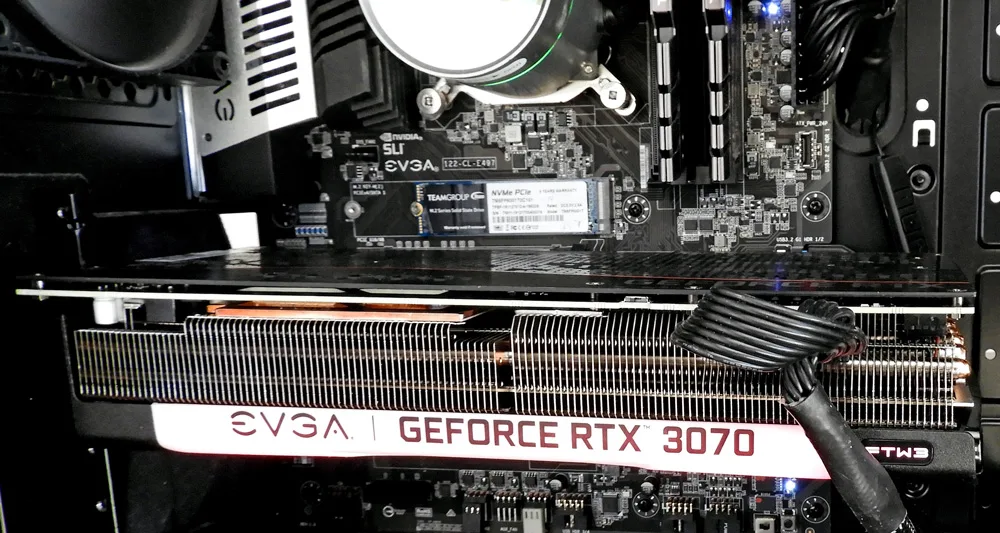 The logo strip has 60 LEDs for a customizable RGB experience that can be synched to other EVGA component lighting. Unfortunately, we didn’t have a lot of luck photographing the customizable lighting, and it locked up leaving us with the logo in red and no way to adjust it even after multiple installs of Precision X1 and the drivers. EVGA’s tech support closed for much of the holidays so we will update this review with a short video if we can get the RGB working properly again. It looked very nice when it was working and there are a multitude of ways to customize the lighting, the colors, and the patterns.
The logo strip has 60 LEDs for a customizable RGB experience that can be synched to other EVGA component lighting. Unfortunately, we didn’t have a lot of luck photographing the customizable lighting, and it locked up leaving us with the logo in red and no way to adjust it even after multiple installs of Precision X1 and the drivers. EVGA’s tech support closed for much of the holidays so we will update this review with a short video if we can get the RGB working properly again. It looked very nice when it was working and there are a multitude of ways to customize the lighting, the colors, and the patterns.
Let’s check out overclocking, temperatures and noise next.
Overclocking, temperatures and noise
Unlike the Founders Edition of the RTX 3070 which is voltage constrained and a fair overclocker, the FTW3 Ultra is not as constrained and is an excellent overclocker. All of our performance and overclocked testing are performed in a closed Phanteks Eclipse P400 ATX mid-tower case. Inside, the EVGA RTX 3070 FTW3 Ultra is a very quiet card even when overclocked and we never needed to increase its fan speeds manually or change the stock fan profile. 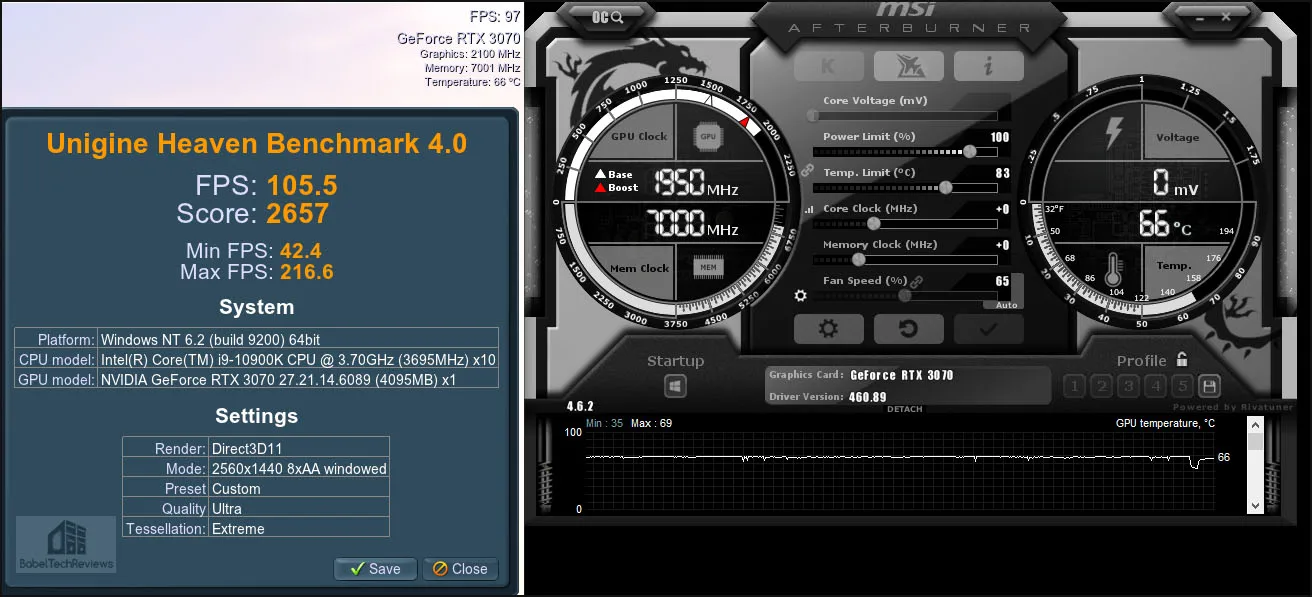 We first tested the RTX 3070 FTW3 using Afterburner at completely stock settings. We used Heaven 4.0 running in a window at completely maxed-out settings at a windowed 2560×1440 to load the GPU to 98% so we could observe the running characteristics of the RTX 3070 FTW3 and also to be able to instantly compare our changed clock settings with their results. At completely stock settings with the GPU under full load, the FTW3 ran cool and stayed below 67C with clocks that averaged a steady 1950MHz.
We first tested the RTX 3070 FTW3 using Afterburner at completely stock settings. We used Heaven 4.0 running in a window at completely maxed-out settings at a windowed 2560×1440 to load the GPU to 98% so we could observe the running characteristics of the RTX 3070 FTW3 and also to be able to instantly compare our changed clock settings with their results. At completely stock settings with the GPU under full load, the FTW3 ran cool and stayed below 67C with clocks that averaged a steady 1950MHz.
Interestingly, our RTX 3070 Founders Edition sample averages above 1900MHz and frequently boosts to 1935MHz and even higher although the GPU temperatures frequently run to almost 75C which means the fans have to spin up higher and they are noisier than the FTW3 although both cards should have similar performance at their respective stock setting.
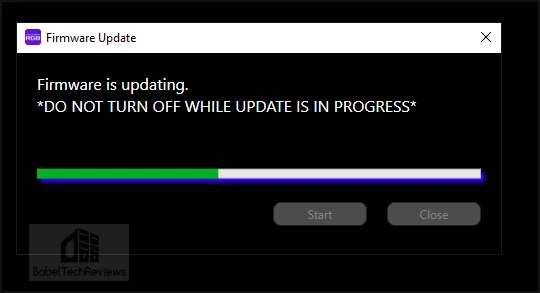 Afterward we uninstalled Afterburner and installed EVGA’s Precision X1 tool which immediately updated the card’s firmware. Next we tried the Precision X1 automatic scan and it suggested adding +106Hz to the core and +200MHz offset to the memory.
Afterward we uninstalled Afterburner and installed EVGA’s Precision X1 tool which immediately updated the card’s firmware. Next we tried the Precision X1 automatic scan and it suggested adding +106Hz to the core and +200MHz offset to the memory.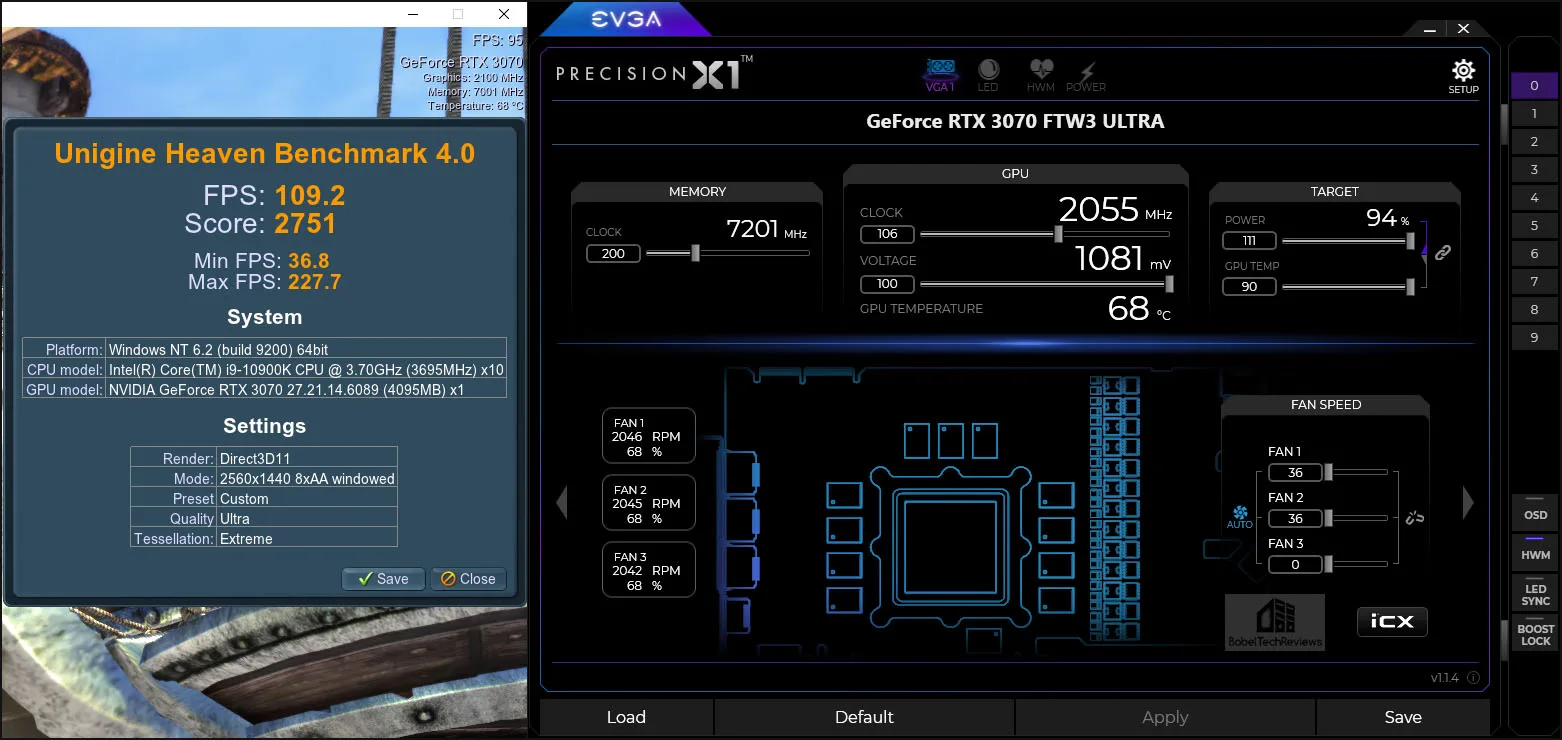
The Precision X1 scan turned out to be accurate regarding the core offset as we could go no higher, but we were able to add +1200MHz to the memory which means that our final overclock reached a very steady 2070MHz with a memory clock of 8200MHz! However, with overclocking, power draw went way up from 220W at stock to 270W and even hit 300W as we increased voltage settings to maximum.
The FTW3 achieved a steady core clock 70Mhz above the Founders Edition’s highest boost clocks, and a 1000MHz higher memory clock – all of this due to EVGA’s picking suitable chips that can handle higher voltage together with a beefier power delivery which is what makes the FTW3 special and also more expensive. The voltage reached 1100mV at times under our maximum overclock, yet the GPU temperatures never reached 70C, and the three fans never had to spin up so as to be noticeable over the other fans in our case.
To see the performance increase from overclocking, we tested 10 representative games and compared overclocks with the Founders Edition. The overclocking results are given in the main performance charts after the section about the RX 6800.
Next, let’s take a closer look at the reference RX 6800.
The Reference RX 6800 – Big Navi 2 Specifications & Features, Unboxing, Overclocking & Noise
We received a reference RX 6800 from AMD after the launch together with a reference RX 6800 XT which we reviewed versus the Red Devil RX 6800 XT and versus the RTX 3080. The RX 6800 has the same architecture as the RX 6900 XT and the RX 6800 XT, but it has less compute units and stream processors and the game clocks are lower with an advantage of a lower power draw. However, all three cards sport 16GB DDR6 compared to the 10GB DDR6 of the RTX 3070 and RTX 3080 (DDR6X). The following chart shows the differences and similarities of the Big Navi 2 Radeon 6000 series.
The Big Navi 2 Radeon 6000 family
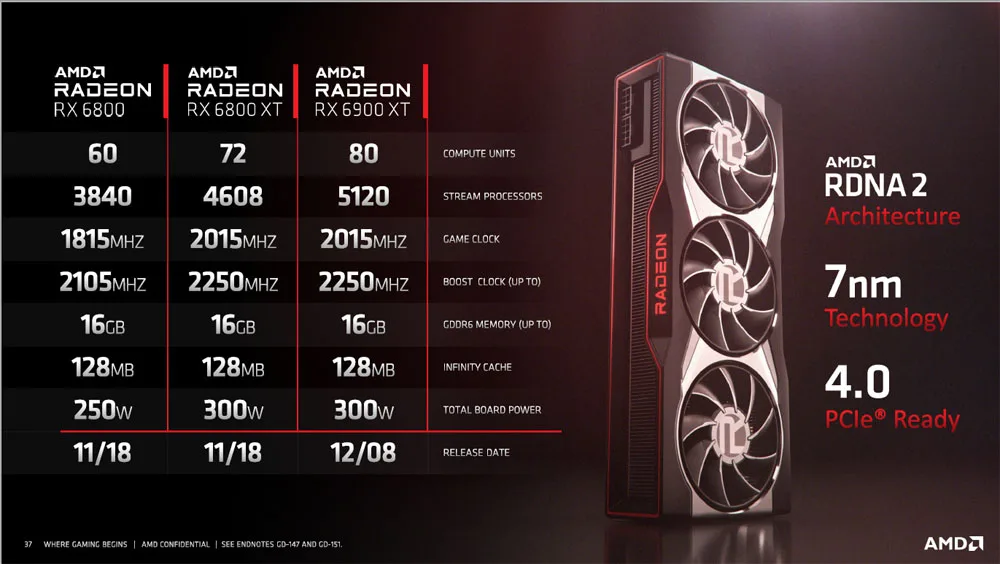 The RTX 6900 XT released at $999 to compete with the $1499 RTX 3090 while the RTX 6800 XT at $649 competes with the RTX 3080 at $699. Both of these cards are slower than their GeForce competitors but the Radeon 6800 competes with the $499 RTX 3070 and is priced higher at $579 as it is expected to be faster at rasterized games.
The RTX 6900 XT released at $999 to compete with the $1499 RTX 3090 while the RTX 6800 XT at $649 competes with the RTX 3080 at $699. Both of these cards are slower than their GeForce competitors but the Radeon 6800 competes with the $499 RTX 3070 and is priced higher at $579 as it is expected to be faster at rasterized games.
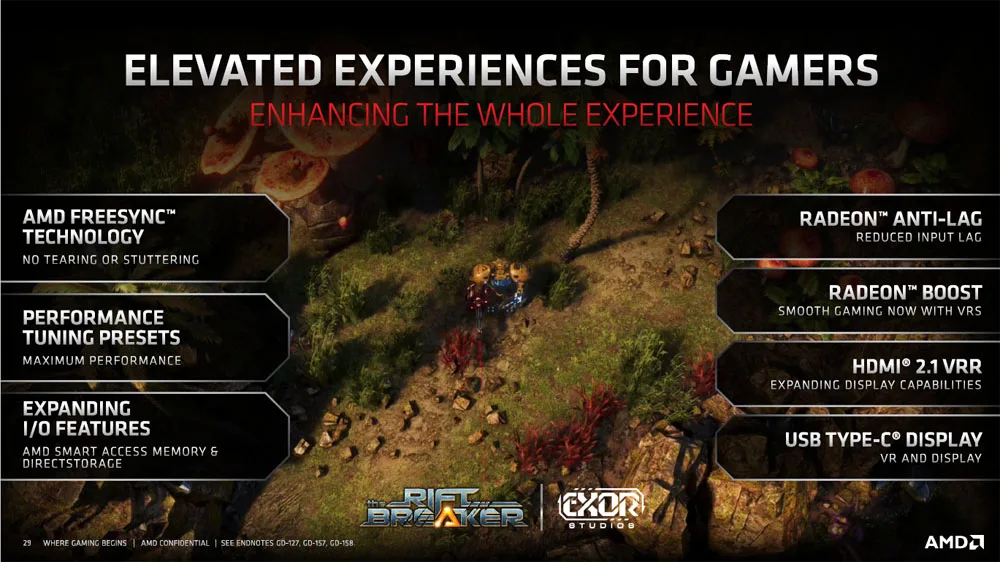 Just like NVIDIA, AMD has their own thriving ecosystem for gamers with many unique new features for the Radeon 6000 series. AMD touts the “open” system while NVIDIA’s tends to be more proprietary, each attracting fans who may prefer one gaming ecosystem over the other. Interestingly, AMD has adopted USB Type C for VR and displays while NVIDIA has dropped it from Ampere cards after using it for Turing.
Just like NVIDIA, AMD has their own thriving ecosystem for gamers with many unique new features for the Radeon 6000 series. AMD touts the “open” system while NVIDIA’s tends to be more proprietary, each attracting fans who may prefer one gaming ecosystem over the other. Interestingly, AMD has adopted USB Type C for VR and displays while NVIDIA has dropped it from Ampere cards after using it for Turing.
Let’s unbox the reference RX 6800.
Unboxing
The reference RX 6800 box shows just a partial image of the card with “Radeon RX 6800” text. That’s it on the front.
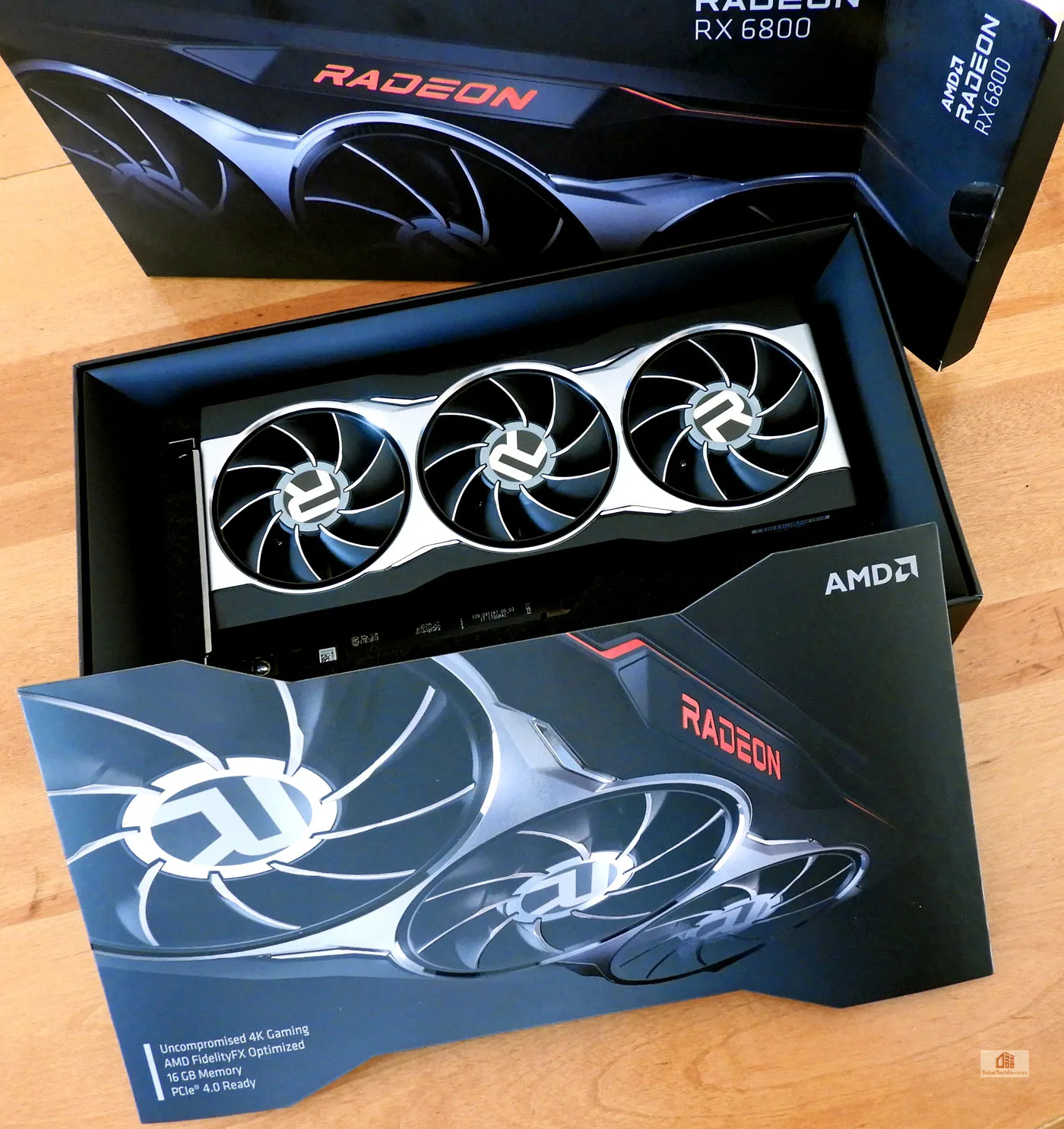 The back of the box doesn’t advertise features nor give any useful information except to direct the buyer to www.amd.com/RadeonUserManual for a quickstart guide and warranty information.
The back of the box doesn’t advertise features nor give any useful information except to direct the buyer to www.amd.com/RadeonUserManual for a quickstart guide and warranty information.
Opening the well-padded box, we see the card inside (above). There are no bundled games and the packing is barebones compared with AMD’s partners’ cards such as PowerColor’s bundle.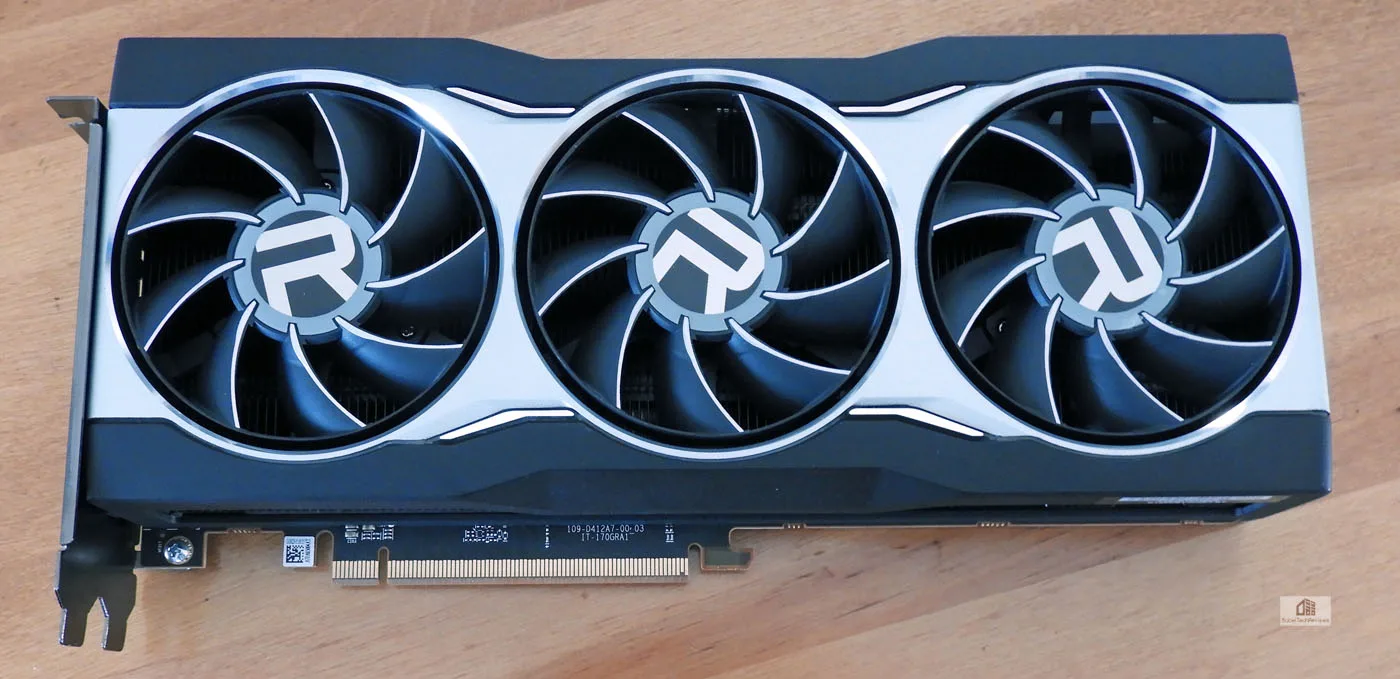 The reference RX 6800 is a large tri-fan card in a two slot design which is quite handsome using AMD’s reference design. The 6800 is very much a twin to the RX 6800 XT in looks and in size.
The reference RX 6800 is a large tri-fan card in a two slot design which is quite handsome using AMD’s reference design. The 6800 is very much a twin to the RX 6800 XT in looks and in size.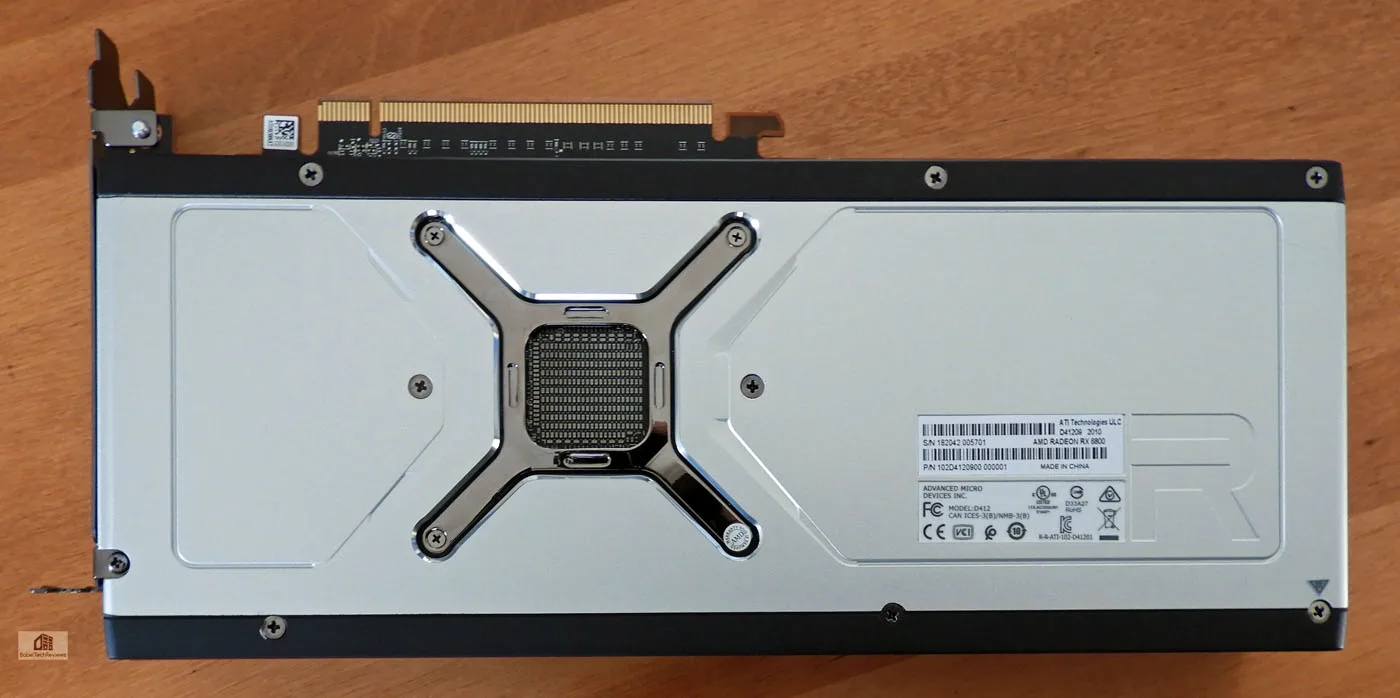
Above is the reference RX 6800 XT backplate. It has a very clean design top and bottom.
It uses two 1×8-pin PCIe connections and the heatsink can be seen along both edges.

Just like the other Big Navi 2 cards, the IO panel sports a Type-C USB connector for display and VR as well as two DisplayPort 1.4 ports plus a HDMI 2.1 port that can handle 4K/120Hz over a single cable.

We didn’t spend very much time overclocking the RX 6800. It has rather limited performance headroom with less than a 10% overclock as AMD evidently preferred giving everyone the highest performance they could get out of all of their new cards and Wattman is rather locked down regarding clocks and voltage. But the reference design is probably AMD’s best design to date, and the card runs very cool and quiet even under load.
Overclocking, temperatures and noise
The reference RX 6800 is a fair overclocker. All of our performance and overclocked testing are performed in a closed Phanteks Eclipse P400 ATX mid-tower case. Inside, the RX 6800 is a quiet card even when overclocked and we never needed to increase its fan speeds manually or change the stock fan profile.
Here are the default Wattman settings above using Heaven to load the GPU to above 98%.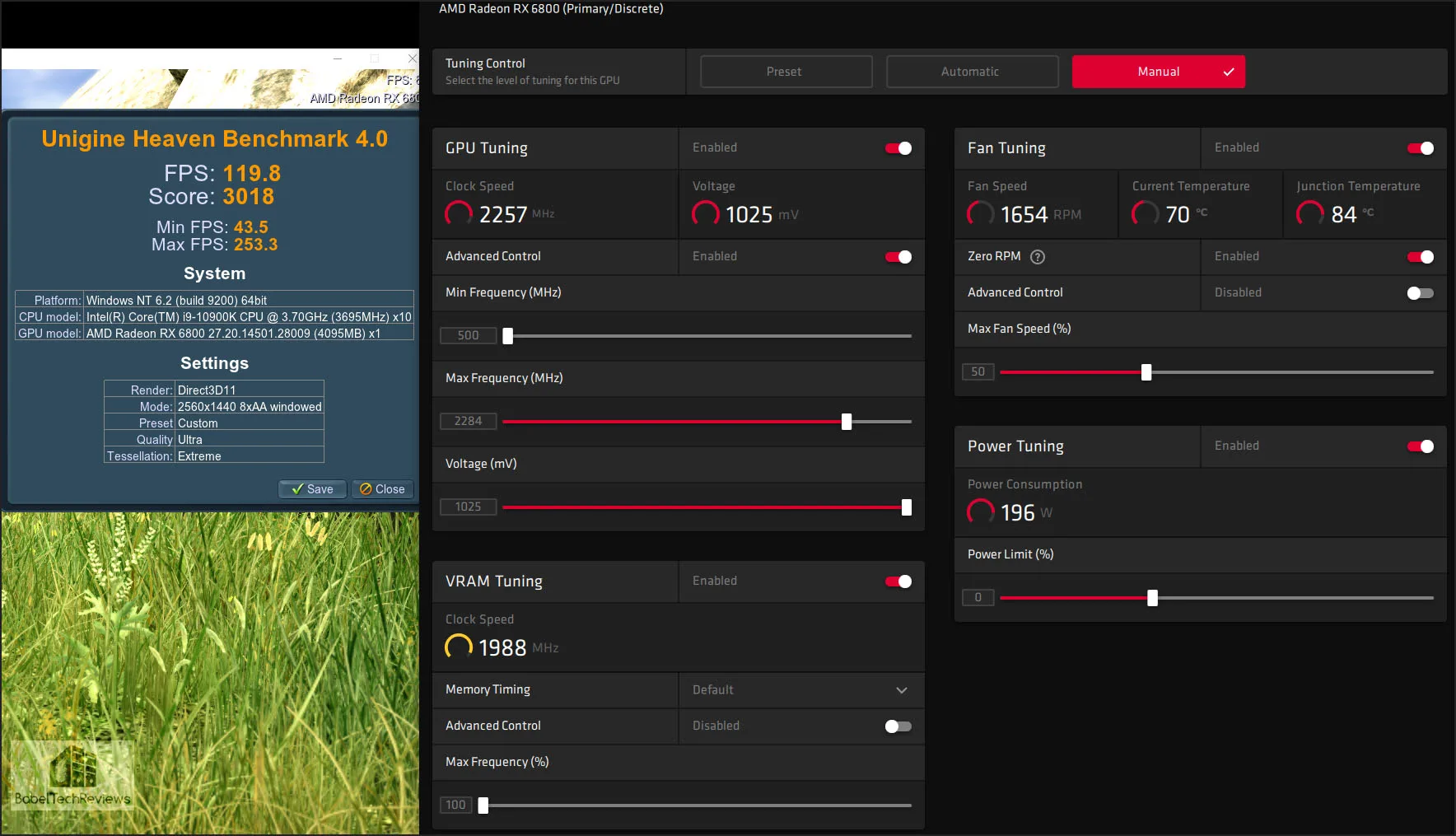
Fan speeds are low and the RX 6800 boosts easily to 2257MHz at stock. Next we overclocked it.
The reference RX 6800 when overclocked between a minimum frequency of 2350Mhz and a maximum of 2450MHz, the Radeon Boost generally stays above 2400MHz with the memory at 2140MHz which provides better than a 4% performance boost for Heaven 4.0. We were unable to hit 2500MHz and memory is locked down to +7% overclock. It may be possible to fine tune this overclock further by trial-and-error undervolting/overclocking, but we found that it was necessary to increase the Power Limit to even hit 2450Mhz.
Even overclocked, the reference RX 6800 stays cool below 75C, and the fans are never irritating when they become audible under full load.
Let’s check out its performance compared with the EVGA RTX 3070 FTW3 Ultra and the RTX 3`070 FE after we look over our test configuration on the next page.
Test Configuration – Hardware
- Intel Core i9-10900K (HyperThreading/Turbo boost On; All cores overclocked to 5.1GHz/5.0Ghz. Comet Lake DX11 CPU graphics)
- EVGA Z490 FTW motherboard (Intel Z490 chipset, v1.9 BIOS, PCIe 3.0/3.1/3.2 specification, CrossFire/SLI 8x+8x), supplied by EVGA
- T-FORCE DARK Z 32GB DDR4 (2x16GB, dual channel at 3600MHz), supplied by Team Group
- Radeon RX 6800 Reference version 16GB, stock settings, on loan from AMD
- EVGA RTX 3070 FTW3 Ultra 8GB, at factory clocks and further manually overclocked, on loan from EVGA
- RTX 3070 Founders Edition 8GB, stock, on loan from NVIDIA
- Radeon RX 6800 XT Reference version 16GB, stock settings, on loan from AMD
- Radeon RX 5700 XT 8GB Anniversary Edition, stock AE clocks.
- RTX 3090 Founders Edition 24GB, stock clocks, on loan from NVIDIA
- RTX 3080 Founders Edition 10GB, stock clocks, on loan from NVIDIA
- RTX 2080 Ti Founders Edition 11GB, stock clocks, on loan from NVIDIA
- RTX 2080 SUPER Founders Edition 8GB, stock clocks, on loan from NVIDIA
- RTX 2070 Ti Founders Edition 8GB, stock clocks, on loan from NVIDIA
- GTX 1080 Ti Founders Edition 11GB, stock clocks, on loan from NVIDIA
- 1TB Team Group MP33 NVMe2 PCIe SSD for C: drive
- 1.92TB San Disk enterprise class SATA III SSD (storage)
- 2TB Micron 1100 SATA III SSD (storage)
- 1TB Team Group GX2 SATA III SSD (storage)
- 500GB T-FORCE Vulcan SSD (storage), supplied by Team Group
- ANTEC HCG1000 Extreme, 1000W gold power supply unit
- BenQ EW3270U 32″ 4K HDR 60Hz FreeSync monitor
- Samsung G7 Odyssey (LC27G75TQSNXZA) 27″ 2560×1440/240Hz/1ms/G-SYNC/HDR600 monitor
- DEEPCOOL Castle 360EX AIO 360mm liquid CPU cooler
- Phanteks Eclipse P400 ATX mid-tower (plus 1 Noctua 140mm fan) – All benchmarking and overclocking performed with the case closed
Test Configuration – Software
- GeForce 460.89 for the RTX 3070s, 456.96 for the RTX 2080 Ti, and the RTX 2070/2080 SUPER; and GeForce 456.16 Press drivers and GeForce 456.38 public drivers (functionally identical) are used for the other GeForce cards.
- Adrenalin 2020 Edition 20.12.1/2 drivers used for the RX 6800 and 6800 XT reference. Adrenalin 2020 Edition 20.10.1 drivers used for the RX 5700 XT Anniversary Edition (AE) at AE clocks.
- High Quality, prefer maximum performance, single display, set in the NVIDIA control panel.
- VSync is off in the control panel and disabled for each game
- AA enabled as noted in games; all in-game settings are specified with 16xAF always applied
- Highest quality sound (stereo) used in all games
- All games have been patched to their latest versions
- Gaming results show average frame rates in bold including minimum frame rates shown on the chart next to the averages in a smaller italics font where higher is better. Games benched with OCAT show average framerates but the minimums are expressed by frametimes (99th-percentile) in ms where lower numbers are better.
- Windows 10 64-bit Pro edition; latest updates v2004. DX11 titles are run under the DX11 render path. DX12 titles are generally run under DX12, and multiple games use the Vulkan API.
- Latest DirectX
- MSI’s Afterburner, 4.6.3 beta
- Precision X1, latest beta
Games
Vulkan
- DOOM Eternal
- Red Dead Redemption 2
- Ghost Recon: Breakpoint
- Wolfenstein Youngblood
- World War Z
- Strange Brigade
- Rainbow 6 Siege
DX12
- Cyberpunk 2077
- Call of Duty Black Ops: Cold War
- Assassin’s Creed: Valhalla
- Watch Dogs: Legion
- Horizon Zero Dawn
- Death Stranding
- F1 2020
- Mech Warrior 5: Mercenaries
- Gears 5
- Anno 1800
- Tom Clancy’s The Division 2
- Metro Exodus
- Civilization VI – Gathering Storm Expansion
- Battlefield V
- Shadow of the Tomb Raider
- Project CARS 2
- Forza 7
DX11
- Crysis Remastered
- Mech Warrior 5: Mercenaries
- Star Wars: Jedi Fallen Order
- The Outer Worlds
- Destiny 2 Shadowkeep
- Borderlands 3
- Total War: Three Kingdoms
- Far Cry New Dawn
- Assetto Corsa: Competitione
- Monster Hunter: World
- Overwatch
- Grand Theft Auto V
Synthetic
- TimeSpy (DX12)
- 3DMark FireStrike – Ultra & Extreme
- Superposition
- Heaven 4.0 benchmark
- AIDA64 GPGPU benchmarks
- Blender 2.90 benchmark
- Sandra 2020 GPGPU Benchmarks
- SPECworkstation3
- SPECviewperf 2020
NVIDIA Control Panel settings
Here are the NVIDIA Control Panel settings.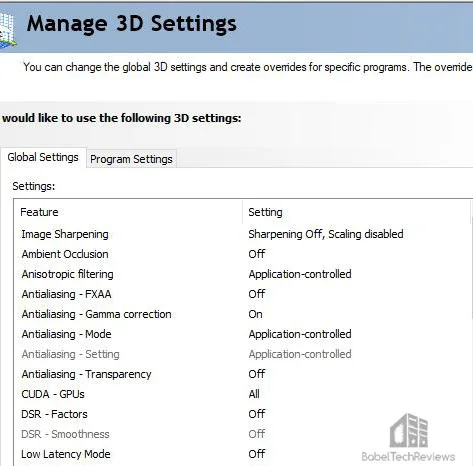


We used MSI’s Afterburner to set all video cards’ power and temperature limits to maximum.
AMD Adrenalin Control Center Settings
All AMD settings are set so that all optimizations are off, Vsync is forced off, Texture filtering is set to High, and Tessellation uses application settings. All Navi cards are capable of high Tessellation unlike earlier generations of Radeons.
Anisotropic Filtering is disabled by default but we always use 16X for all game benchmarks.
Let’s head to the performance charts to check the performance of the reference RX 6800 versus the EVGA RTX 3070 FTW3 Ultra and how they compare with 8 other cards.
Performance summary charts
Here are the performance results of 35 games and 3 synthetic tests comparing the Red Devil RX 6800 XT 16GB with the RTX 3080 FE 10GB and versus the reference RTX 6800 XT plus seven other cards all at their factory set clocks. The highest settings are used and are listed on the charts. The benches were run at 1920×1080, 2560×1440, and 3840×2160. Click on each chart to open in a pop-up for best viewing.
Most gaming results show average framerates in bold text, and higher is better. Minimum framerates are next to the averages in italics and in a slightly smaller font. The games benched with OCAT show average framerates but the minimums are expressed by frametimes in ms where lower numbers are better.
The EVGX RTX 3070 FTW3 vs the reference RX 6800 and vs. the RTX 3070 Founders Edition (FE)
The first set of charts show the 3 main competing cards plus each vendor’s higher-tier card. Column one represents the EVGA RTX 3070 FTW3 ($609) next to the RX 6800 reference version ($579) in column two. Column three represents the RTX 3070 FE ($499) followed by the RX 6800 XT reference version ($699) in column four and the RTX 3080 FE ($649) in the fifth and last column. ‘Wins’ between the FTW3 and the 6800 are denoted by yellow text and if there is a performance tie, both sets of numbers are colored.
The RX 6800 is faster than either RTX 3070 at rasterized games which represent more than 99% of games currently. We note that the FTW3 isn’t that much faster than the Founders Edition when both cards are at stock clocks, so it’s hard to justify EVGA’s $110 premium so far. We also note that the games where DLSS is enabled, either RTX 3070 is faster, but so far, there are a total of 30 games that support NVIDIA’s DLSS. As we understand it, AMD is working on its own version of AI upscaling to compete with DLSS.
Let’s see how the reference RX 6800 and the two RX 3070s fit in our expanded main summary chart, the “Big Picture”, comparing a total of eleven cards.
The Big Picture
Here we see the reference RX 6800 performance compared both RTX 3070s and with eight other cards on recent drivers. This time the reference RX 6800 has all of its performance results in yellow text and the RTX 3070 FTW3 in gold text so they stand out.
Next we look at six ray traced enabled games, each using maximum ray traced settings where available.
Ray Traced Benchmarks
The EVGA RTX 3070 FTW3 and FE are next compared to the reference RX 6800 together with 6 other cards when ray tracing is enabled in six games. ‘Wins’ between the FTW3 and the 6800 are denoted by yellow text and if there is a performance tie, both sets of numbers are colored yellow.
The RX 6800 now appears to perform well behind the RTX 3070s with performance similar to the RTX 2070 Super class when ray tracing features are enabled in-game. But AMD has no hardware equivalent to NVIDIA’s dedicated AI Tensor cores, so it cannot take advantage of DLSS enabled games which puts its ray tracing performance even further behind.
Although AMD has promised a DLSS equivalent in the future, Big Navi 2 cannot currently compete with the RTX 3000 series in ray traced games. If a gamer wants ray tracing with decent performance now, NVIDIA is the best choice. But if a gamer doesn’t particularly care about the relatively few ray traced games, then AMD makes compelling and competitive video cards that are priced decently.
Next we look at overclocked performance.
EVGA RTX 3070 FTW3 Overclocked benchmarks
We are giving special emphasis to overclocking the EVGA RTX 3070 FTW3 because it is a card that is priced nearly $110 higher ($609) than the reference version ($499) and it is in more-or-less direct competition with the RX 6800 reference version that is $40 cheaper ($579). The FTW3 allows for a higher voltage than many of NVIDIA’s partners.
In the first column is the EVGA RTX 3070 FTW3 Ultra overclocked manually next to the factory clocked FTW3 in the second column. The reference 6800 is in the middle/third column followed by the RTX 3070 FE in the fourth, and the overclocked FE in the last/fifth column. Wins between the stock RTX 3070 FTW3 and the RX 6800 are given by yellow text; but if the overclocked FTW3 is faster than the RX 6800, its results are also given in yellow text.
These ten benchmarks demonstrate the superior overclocking ability of the EVGA FTW3 card over the RTX 3070 Founders Edition which somewhat justify its $110 price increase as we see the FTW3 finally trading blows with the RX 6800. Of course, we did not overclock the RX 6800 for this review since we want to primarily compare FTW3 versus FE overclocking.
Let’s look at non-gaming applications next to see how the RTX 3070s compare with the RX 6800 starting with Blender.
Blender 2.90 Benchmark
Blender is a very popular open source 3D content creation suite. It supports every aspect of 3D development with a complete range of tools for professional 3D creation.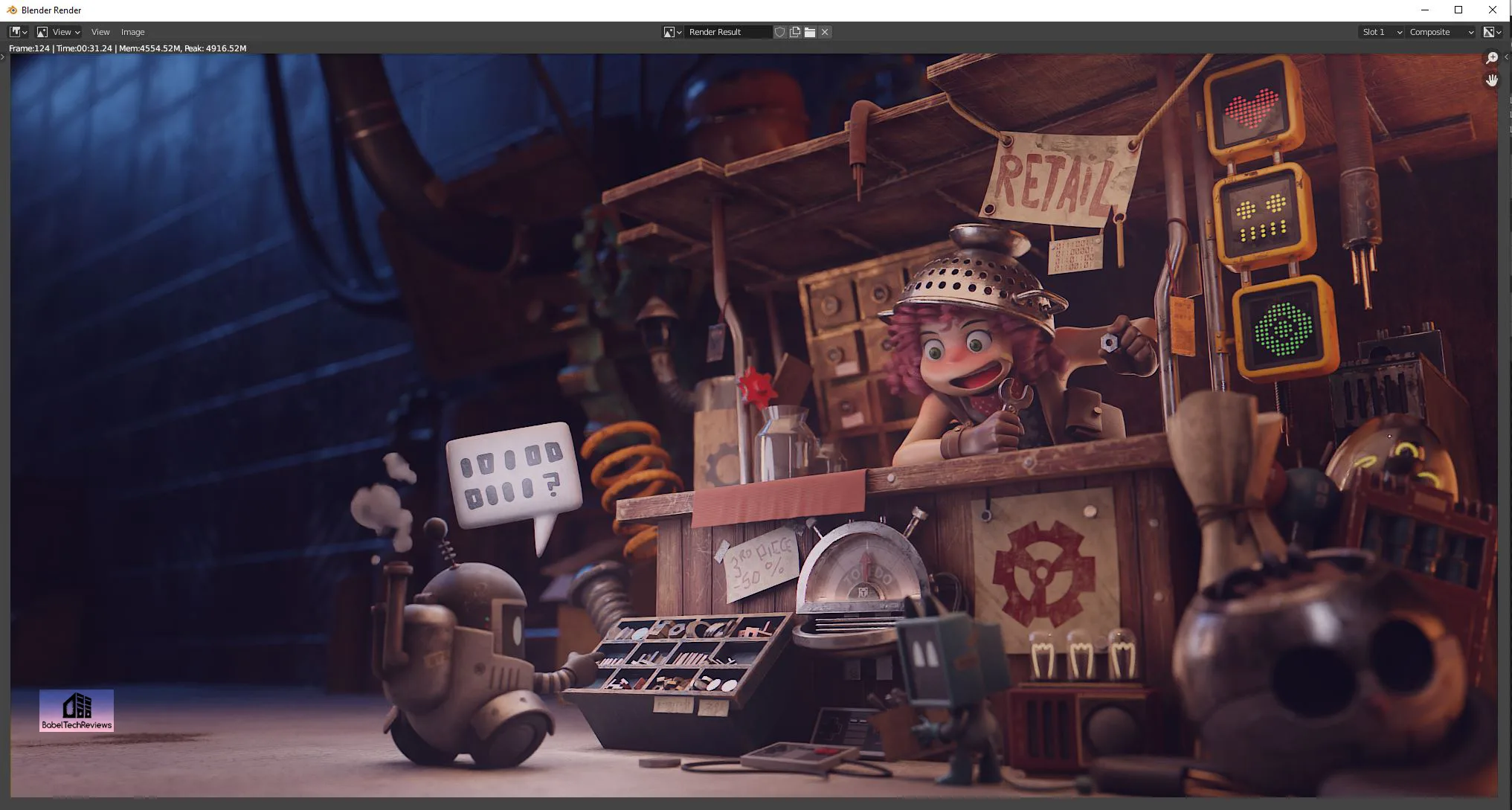
We benchmarked three Blender 2.90 benchmarks which measure GPU performance by timing how long it takes to render production files. We tested seven of our comparison cards with both CUDA and Optix running on the GPU instead of using the CPU. We did not benchmark the RX 5700 XT using OpenCL.
For the following chart, lower is better as the benchmark renders a scene multiple times and gives the results in minutes and seconds.
Here are the EVGA RTX 3070 FTW3 Blender results, first with CUDA and then with Optix:
Here are the RX 6800 reference results using OpenCL: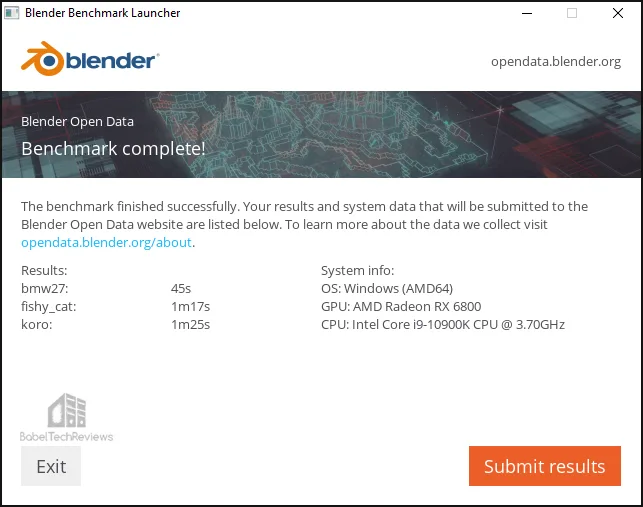
Here are the Blender Big Picture 2.90 benchmark results ranking 11 cards.
 Blender’s benchmark performance is similar using the RX 6800 compared with the RTX 3070s although the performance results depend on the scene rendered.
Blender’s benchmark performance is similar using the RX 6800 compared with the RTX 3070s although the performance results depend on the scene rendered.
Next, we move on to AIDA64 GPGPU benchmarks.
AIDA64 v6.25
AIDA64 is an important industry tool for benchmarkers. Its GPGPU benchmarks measure performance and give scores to compare against other popular video cards.
AIDA64’s benchmark code methods are written in Assembly language, and they are well-optimized for every popular AMD, Intel, NVIDIA and VIA processor by utilizing the appropriate instruction set extensions. We use the Engineer’s full version of AIDA64 courtesy of FinalWire. AIDA64 is free to to try and use for 30 days. CPU results are also shown for comparison with both the RTX 3070 and GTX 2080 Ti GPGPU benchmarks.
Here are the EVGA RTX 3070 FTW3 AIDA64 GPGPU results compared with an overclocked i9-10900K
Next are the reference RX 6800 AIDA64 GPGPU results compared with an overclocked i9-10900K.
Here is the chart summary of the AIDA64 GPGPU benchmarks with ten of our competing cards side-by-side.
The RX 6800 is a fast GPGPU card and it compares favorably with the Ampere cards being weaker in some areas and stronger in others. So let’s look at Sandra 2020 next.
SiSoft Sandra 2020
To see where the CPU, GPU, and motherboard performance results differ, there is no better tool than SiSoft’s Sandra 2020. SiSoftware SANDRA (the System ANalyser, Diagnostic and Reporting Assistant) is a excellent information & diagnostic utility in a complete package. It is able to provide all the information about your hardware, software, and other devices for diagnosis and for benchmarking. Sandra is derived from a Greek name that implies “defender” or “helper”.
There are several versions of Sandra, including a free version of Sandra Lite that anyone can download and use. Sandra 2020 R10 is the latest version, and we are using the full engineer suite courtesy of SiSoft. Sandra 2020 features continuous multiple monthly incremental improvements over earlier versions of Sandra. It will benchmark and analyze all of the important PC subsystems and even rank your PC while giving recommendations for improvement.
The author of Sandra 2020 informed us that while NVIDIA has sent some optimizations, they are generic for all cards, not Ampere specific. The tensors for FP64 & TF32 have not been enabled in Sandra 2020 so GEMM & convolution running on tensors will get faster using Ampere’s tensor cores. BF16 is supposed to be faster than FP16/half-float, but since precision losses are unknown it has not yet been enabled either. And finally, once the updated CUDA SDK for Ampere gets publicly released, Sandra GPGPU performance should improve also.
With the above in mind, we ran Sandra’s intensive GPGPU benchmarks and charted the results summarizing them.
Since the architectures are different, each card exhibits different characteristics with different strengths and weaknesses. However, we see very solid improvements of the RX 6800 over the RX 5700 XT as well as Ampere’s improvement over Turing.
SPECworkstation3 (3.0.4) Benchmarks
All the SPECworkstation3 benchmarks are based on professional applications, most of which are in the CAD/CAM or media and entertainment fields. All of these benchmarks are free except for vendors of computer-related products and/or services.
The most comprehensive workstation benchmark is SPECworkstation3. It’s a free-standing benchmark which does not require ancillary software. It measures GPU, CPU, storage and all other major aspects of workstation performance based on actual applications and representative workloads. We only tested the GPU-related workstation performance as checked in the image above.
Here are the EVGA RTX 3070 FTW3 SPECworkstation3 results including the Raw Scores.
Here are the reference RX 6800 SPECworkstation3 results.
Here is the chart summary of the SPECworkstation3 benchmarks with 10 of our competing cards side-by-side.
Since the architectures are different, the cards each exhibit different characteristics with different strengths and weaknesses.
SPECviewperf 2020 GPU Benches
The SPEC Graphics Performance Characterization Group (SPECgpc) has released a new 2020 version of its SPECviewperf benchmark recently that features updated viewsets, new models, support for both 2K and 4K display resolutions, and improved set-up and results management.
We benchmarked at 4K and here are the EVGA RTX 3070 FTW3 SPECviewperf 2020 results.
Here are the reference RX 6800 SPECviewperf 2020 results.
Here are the SPECviewperf 2020 results summarized in a chart comparing the reference RX 6800 with the EVGA RTX 3070 FTW3 along with 6 other competing cards. Higher is better.
Again we see different architectures with different strengths and weaknesses. The reference version and the FTW3 are fairly close in performance as are the two RX 6800s.
After seeing these benches, some creative users will probably upgrade their existing systems with a new card based on the performance increases and the associated increases in productivity that they require. The question to buy a new video card should be based on the workflow and requirements of each user as well as their budget. Time is money depending on how these apps are used. However, the target demographic for the RTX 3070 and the RX 6800 are primarily gaming for gamers.
Let’s head to our conclusion.
The Conclusion
The reference RX 6800 improves significantly over the RX 5700 XT and it trades blows and mostly beats the RTX 3070 in rasterized games. The reference RX 6800 beats the last generation cards including the RTX 2080 Super/Ti although it struggles with ray traced games especially when compared to DLSS which is used for the GeForce cards. We also note that the reference RX 6800 is overall faster for VR gaming than the RTX 3070 Founders Edition but we have not compared it against the FTW3. Only when the EVGA card is overclocked does it pull away from an overclocked RTX 3070 FE and really trade blows with the RX 6800.
For Radeon gamers, the reference RX 6800 is a very good alternative to GeForce Ampere cards for the vast majority of modern PC games that use rasterization. In addition, the RX 6800 offers 16GB of GDDR6 to the 8B of GDDR6 that the RTX 3070s are equipped with.
At its suggested price of $579, the reference RX 6800 offers a good value – if it can be found at all. Unfortunately, this Big Navi 2 launch has proved to be an extremely high demand and limited supply event that has been called a paper launch by many wishing to purchase one. The same thing has happened to Ampere cards where the stock is still trickling in and being purchased the instant it’s available. So prices are high and many resellers are taking advantage of this demand situation by raising prices significantly.
However, the RTX 3070 Founders Edition also offers a good value at $499. For $80 less than the RX 6800, it gives similar if a bit slower performance, but it excels in ray traced games and in the 30 games where DLSS is available. On the other hand, $609 for the EVGA RTX 3070 FTW3 is a harder sell at $110 more than the Founders Edition. It has a difficult time justifying its value based on stock performance, and only excels once it is overclocked manually. But the real issue in our opinion is that the EVGA RTX 3070 FTW3 Ultra is priced only $40 $90 less than a RTX 3080 Founders Edition which is significantly faster than any RTX 3070 or even any 6800 series card.

The EVGA RTX 3070 FTW3 Ultra Pros
- The EVGA RTX 3070 FTW3 Ultra is a fast 1440P card that trades blows with the RX 6800 once overclocked.
- Overclocking headroom appears to be solid and better than the Founders Editions.
- The FTW3 sports a Dual BIOS for overclockers looking to push the card’s limits. And multiple sensors across the board monitor VRM/memory temps in Precision X1 giving enthusiasts more fine tuning controls.
- The RTX 3070 FTW3 Ultra stays cool and quiet even when overclocked.
- It’s an RGB card with the RGB and Fan Header integrated with good control over lighting patterns and colors
- It is a solid and well built card with all of NVIDIA’s RTX features including fast ray tracing with DLSS.
- Excellent gaming platform ecosystem.
- EVGA offers a 3 year warranty and backs it with some of the best customer and warranty service available anywhere.
RTX 3070 FTW3 Cons
- Expensive at $610 compared with the $499 Founders Edition and only $90 less than a much faster RTX 3080 FE
- Hard to find in stock; an interested buyer may be able to get into EVGA’s queue system.
The Reference RX 6800 Pros
- The reference RX 6800 is much faster than the last generation RX 5700 series by virtue of new RDNA 2 architecture. It beats the RTX 2080 Super and the RTX 3070 in rasterized games.
- 16GB vRAM may make the RX 6800 more useful for future gaming than the 8GB vRAM the RTX 3070 is equipped with.
- The reference RX 6800 has excellent cooling and it is probably AMD’s best reference design.
- Solid gaming ecosystem.
RX 6800 Cons
- Impossible to find at a reasonable price.
- Weaker ray tracing performance than the RTX 3070; no DLSS equivalent.
The OVERALL Verdict:
- Let’s sum it up first by looking at the RTX 3070 Founders Edition at $499. Solid value, fair overclocker, slower than the RTX 6800 but priced $80 less – and it excels at ray tracing and DLSS games.
- The RX 6800 also offers a good value at $579 – faster than the $80 cheaper RTX 3070 FE, and faster and $40 less expensive than the EVGA RTX 3070 FTW3 Ultra. Its weakness is ray tracing and lack of a DLSS alternative.
- Finally, the EVGA RTX 3070 FTW2 Ultra is well-built, solid, good-looking, and it overclocks very well to trade blows with the RX 6800 but it is priced somewhat optimistically at $110 more than the slightly slower Founders Edition and $40 more than the faster RX 6800.
There are a lot of great choices from NVIDIA and AMD theoretically to suit any 1440P gamer in the $400 to approximately $600 price range. In reality, the situation is compounded and complicated by the general unavailability of any of these cards and the extreme price gouging taking place by the online sellers. We would love to give a BTR Award badge to each of these cards, but the current situation regarding availability and pricing makes it impossible now. Each of these cards is highly recommended as representing good value depending on what a gamer is specifically looking for.
We can only hope that the availability and pricing situation will get better next year. There will be some great choices on the AMD side – and from NVIDIA and their partners – once they become available at reasonable pricing.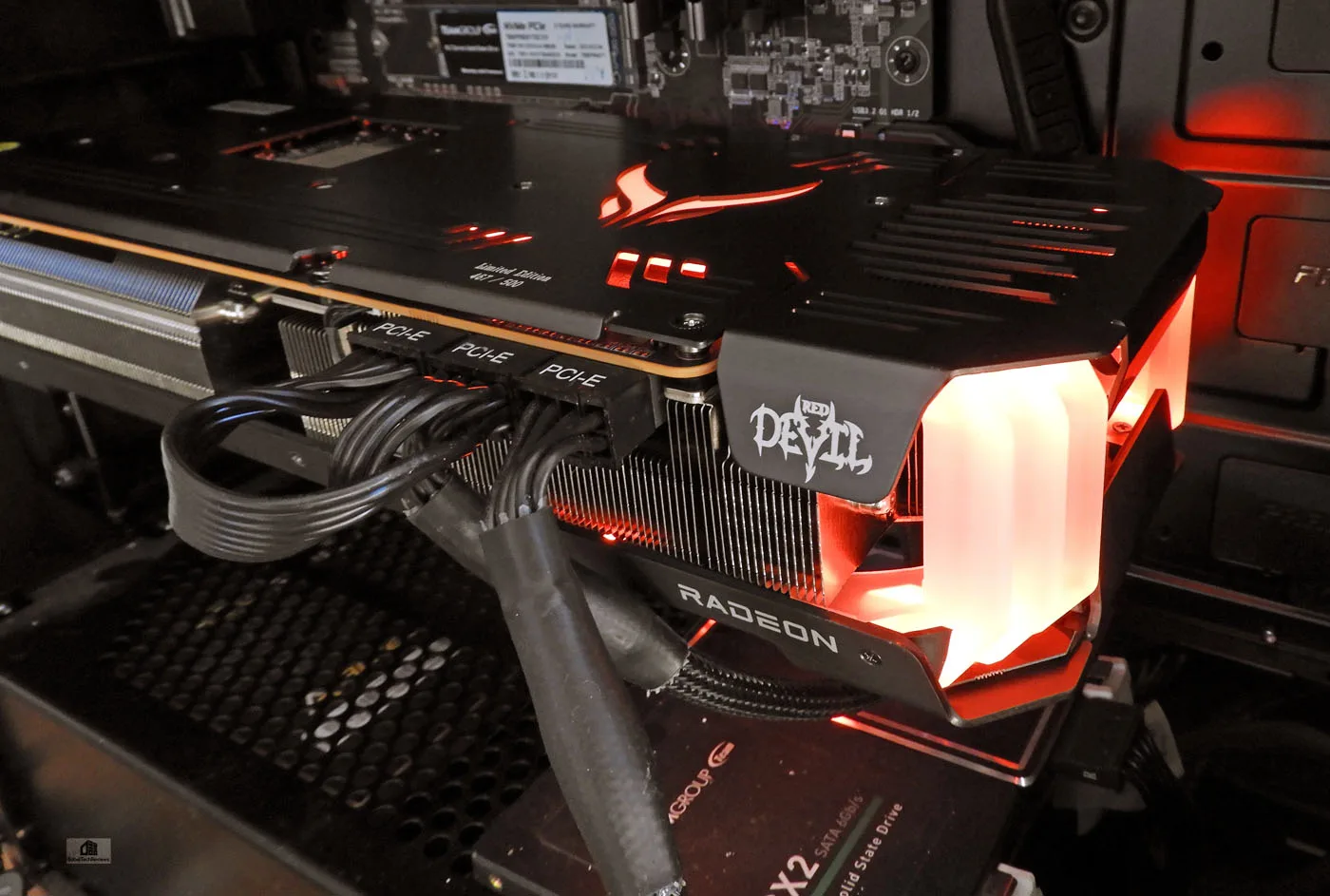
Stay tuned, there is much more coming from BTR. This week we will continue with our Ampere vs Big Navi 2 showdown and will return to VR with a performance evaluation using the Vive Pro comparing the Red Devil RX 6900 XT versus the RTX 3090 followed up by a full 35-game pancake review of these two flagship cards.
It you would like to comment, please use the section below.
Happy Gaming and Happy 2021!
